Foreword

Councillor Shaun Macaulay
Depute Leader of the Council and Cabinet Member for Education and Young People
This report sets out the progress made in the last year in education across North Ayrshire. It describes what the Education Service has done in partnership with our communities to try to ensure that all our young people achieve their very best. As this report demonstrates, there is a significant amount of hard work taking place across all our educational establishments and the Education Service remains committed to delivering a high quality education provision in environments that nurture learners’ aspirations, support learners to achieve their potential and provide a wide range of opportunities for young people to build their skills and knowledge in preparation for life after school. I am very proud of the achievements of North Ayrshire’s children and young people so far, and I know the service is committed to building on current successes and securing further improvements in the year ahead. I would like to take this opportunity to thank our dedicated staff teams for the fantastic work they do day in day out to improve the life chances of every child in North Ayrshire.
Introduction

Andrew McClelland
Head of Service (Education) and Chief Education Officer
I am delighted to present our annual Standards and Quality Report which summarises some of the fantastic work which has taken place across our Education Service throughout session 2024-25. In North Ayrshire, our staff teams are passionate about doing everything possible to support the children and young people we serve to achieve the best possible outcomes. You will see in this report a flavour of the wide array of activities which took place over the last year across the Education Service to take forward our improvement priorities. Throughout the report, you will read evidence of the improvements we have made to our service and the outcomes our learners have achieved. Our work is very much a team effort, built on strong collaborative partnerships, positive relationships and an unwavering focus on ensuring North Ayrshires children and young people are at the very heart of all that we do. We can and should be proud of our achievements to far, while also recognising and planning our next steps in our ongoing improvement journey. I would like to take this opportunity to thank Education Service staff, families, children and young people for their hard work and collective commitment to learning for North Ayrshires children and young people. Every school and early years centre also has their own version of a Standards and Quality Report in which they share with you their successes and achievements at individual establishment level, as well as their next steps for further improvement. These are available on their websites or directly.
The North Ayrshire local context
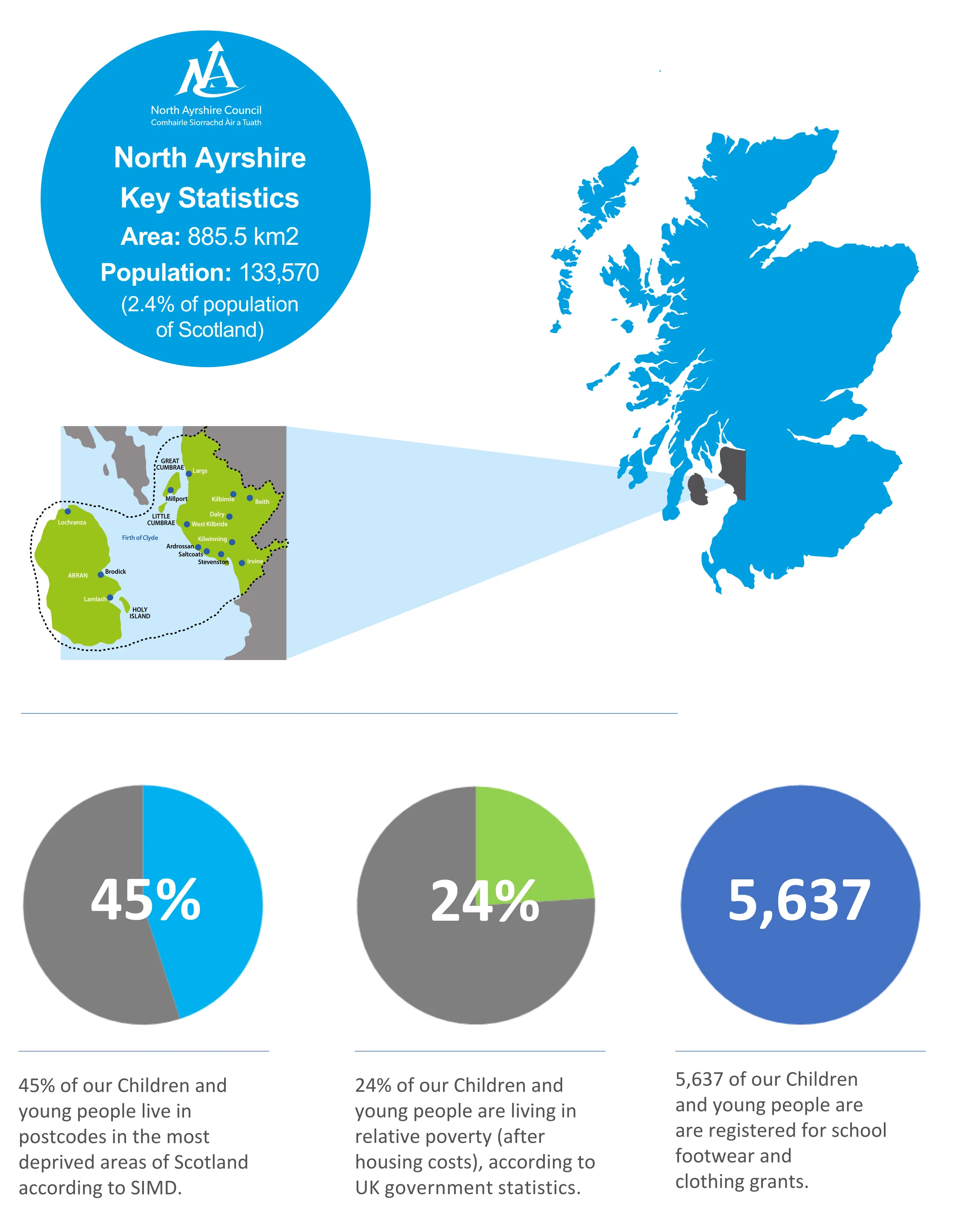
Education in North Ayrshire
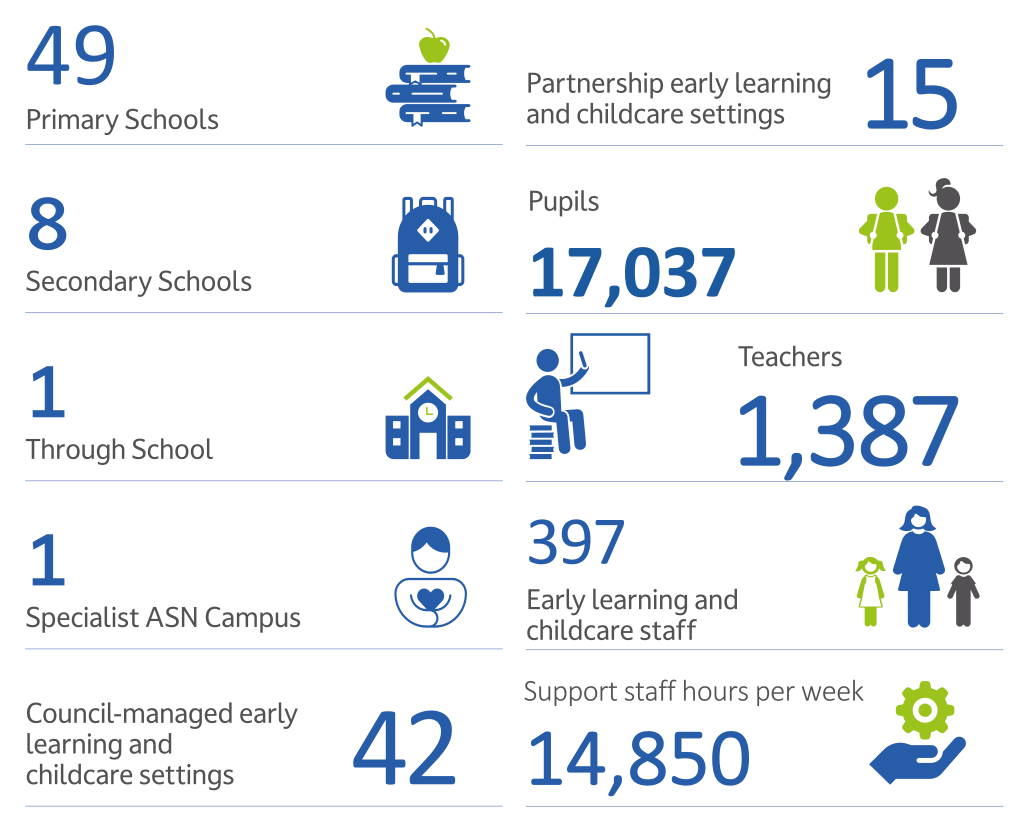
The education service is part of North Ayrshire Council’s Education Directorate, which works towards developing a society where everyone has the same life chances to grow, prosper and have fulfilling and healthy lives. The Education Service has a central role in removing barriers and supporting the delivery of our priority outcomes to ensure North Ayrshire’s children and young people can have the best start in life.
This report details progress made towards our Service Improvement Plan priorities for session 2024-25, which are aligned to the priorities within the National Improvement Framework as follows:
- Improvement in attainment, particularly in literacy and numeracy
- Closing the attainment gap between the most and least disadvantaged children and young people
- Improvement in skills and sustained, positive school-leaver destinations for all young people
- Improvement in children and young people’s health and wellbeing
- Placing human rights and needs of every child and young person at the centre of education
Investing in our Learning Environments
Investment in our school and early years buildings is of vital importance for several reasons: Raising attainment, achievement and wellbeing Enhancing quality and reflecting changes in curriculum Reducing inequality of facilities and opportunity Within North Ayrshire we have an excellent record of continuous improvement across our Learning Estate, and Academic Year 2024/2025 saw a number of major projects progressed which strengthen that commitment.
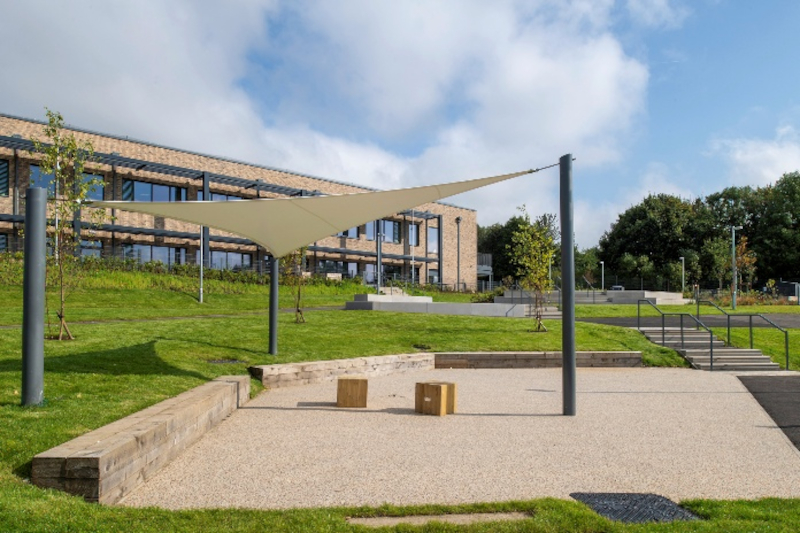
Montgomerie Park Primary School in Irvine opened its doors in August 2024; a completely new school provision to address demographic changes in Irvine, the building is the first North Ayrshire Council property constructed to “Passivhaus” standards – meaning that it is highly energy efficient whilst also providing a comfortable environment for users. The school can accommodate 342 primary pupils and 47 early years pupils and cost c.£20 million.
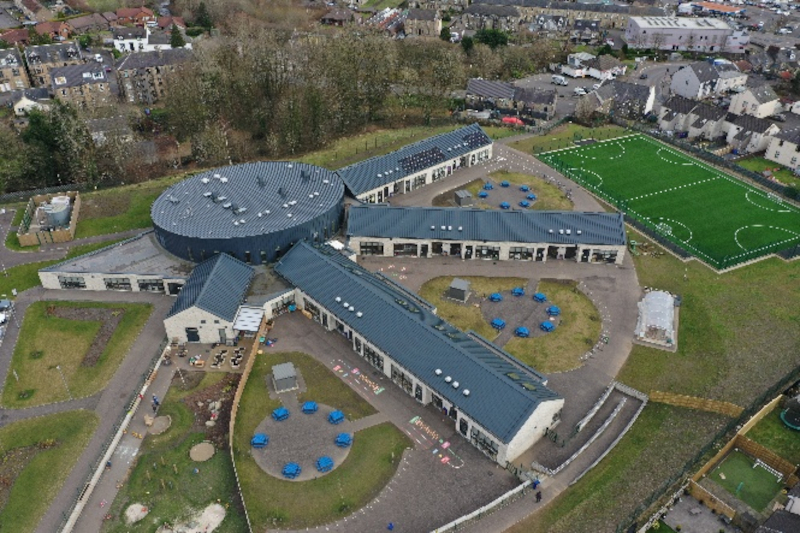
Moorpark Primary School, Kilbirnie (opened October 2024) replaced an ageing school in need of significant maintenance with a highly energy efficient 12 class (+ early years) modern facility with greatly improved dining, physical education and classroom facilities. The innovative design has proved to be very popular with staff, pupils and parents – and allows a wider curriculum to be developed along with a number of different learning environments for the children.
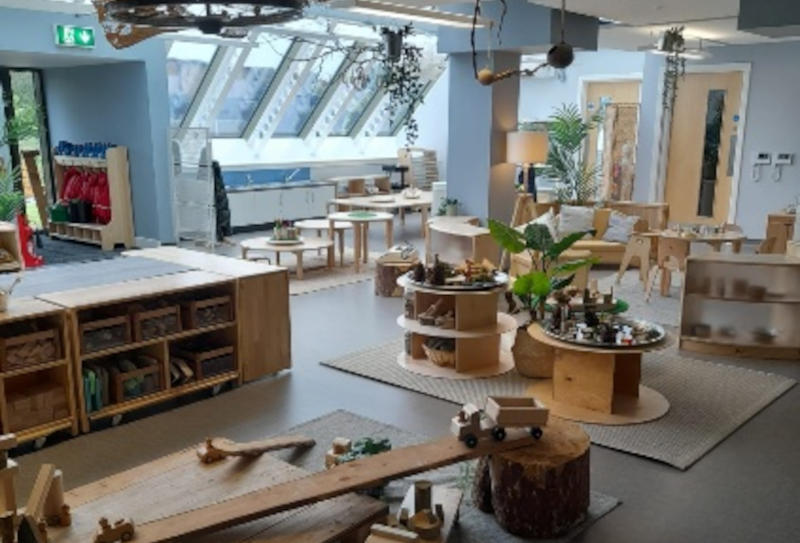
Marress House Early Years Centre, Irvine (opened August 2024) is a repurposed HMRC Office which has been completely refurbished to provide an outstanding early years centre and extensive staff training facilities. The building can accommodate up to 55 children and is an excellent example of how vacant buildings can be redesigned to bring them up to modern building standards, whilst also providing an engaging and highly child-focussed environment.
In addition to these completed builds, 2024/25 saw some key milestones reached in other infrastructure projects:
The Ardrossan Coastal Quarter initiative, which will see Ardrossan Community Campus located on the North Shore site in the town, made significant headway towards the full remediation of the agreed site for the new campus building, allowing the campus construction to commence. The campus will cater for children aged 2-18 in a school with early years, primary, secondary and targeted ASN provisions, a shared public/school library, public leisure facilities including two swimming pools, and be the base for a Social Work Office.
Universal Free School Meals expansion projects were also progressed in 2024/2025, with three funded projects at Loudoun Montgomery Primary School, West Kilbride Primary School and Glebe Primary School moving forward appropriately, as necessary to meet their respective target completion dates.
The design at Loudoun Montgomery Primary School is the furthest progressed as delivery is due in 2026. Planning permission has been sought to allow construction to begin in 2025, which will see revised and separate dining facilities being created from existing space, with new classrooms being provided to ameliorate for the surrendered space.
Education Service Improvement Plan Priorities 2023-26
Our Service Improvement Priorities will remain the same overall between 2023 and 2026. Each year, we will focus on specific actions to take forward those priorities across the service. The table below summarises the key pieces of work we set out to undertake towards our improvement agenda throughout session 2024-2025.
Priority one: Improvement in attainment, particularly in literacy and numeracy
Theme one: High quality learning, teaching and assessment
Continue to enhance the Professional Learning Academy approaches to supporting establishments with improving the quality of learning and teaching and raising attainment: including a refinement of the four blocks of interventions and the expansion of bespoke twilight and in-service training tailored to establishment improvement plans.
Expand approaches to play pedagogy across Early Years establishments and the early stages of Primary to increase impact on children's progress, supported by the development of a suite of audit tools and benchmarking frameworks.
Create a new authority-wide framework for digital learning to support high quality learning and teaching across all schools and Early Year Centres (EYCs)
Theme two: Raising attainment and acheivement
- Effective use of tracking and monitoring and attainment discussions
- Improved data literacy skills across all staff groups (including toolkit)
- The relaunch of raising attainment subject networks and DHT networks (Secondary)
Co-create with senior leaders a NAC Raising Attainment and Achievement strategy which includes:
Implement further target setting arrangements to raise attainment and achievement for all.
Deploy additional teaching staff to support schools to raise attainment, particularly in literacy and numeracy, at key stages.
Priority two: Closing the attainment gap between the most and least disadvantaged children and young people
Theme one: Interventions to reduce gaps
Through regular and robust tracking and monitoring of data, the Early Years Excellence and Equity Leads team will work to support the further reduction of the poverty-related achievement gap.
Theme two: Specific focus on identified groups, including care experienced learners
- The expansion of the programme to include Extended Outreach and Arran
- The provision of bespoke professional learning to MCR Pathways Co-ordinators
- The development of links to primary schools
Continue to deliver and enhance the MCR Pathways programme in all NAC secondary schools to support care experienced learners, including:
Support the delivery of the Promise Education Award with a pilot group of schools.
Priority three: Improvement in skills and sustained, positive school-leaver destinations for all young people
Theme one: Improved skills
- deliver ‘Performing Engineering Operations’ at SCQF Level 5
- develop with Secondary schools learner pathways leading to PEO course
- develop Developing Young Workforce (DYW) links with XLCC to support Secondary schools in creating pathways to relevant employment and training opportunities
Increase direct links within the curriculum to the Ayrshire Growth Deal and design further opportunities for skills development in a range of contexts, including:
Priority four: Improvement in children and young people’s health and wellbeing
Theme one: Supporting mental health and wellbeing
Continue to embed whole school approaches to supporting children’s mental health and wellbeing, ensuring integration with community mental health and wellbeing approaches: including a refresh of our "Be Amazin'" anxiety support resource and the further development of Project Restore.
Theme two: Supporting social and emotional wellbeing
Review approaches to supporting learners with social, emotional and behavioural needs (SEBN) within targeted provisions and mainstream environments.
Update and enhance the Promoting Positive Relationships policy to strengthen approaches to promoting positive behaviour. and refresh the range of evidence based professional learning and interventions to promote emotional regulation, manage conflict and raise adult presence to ensure our educational establishments are places of safety for everyone.
Theme three: Improving attendance
Update the Education Service attendance policy and SEEMIS guidance alongside developing a positive campaign to promote and ensure positive attendance.
Develop a targeted staged approach to early identification of emotionally-based school non-attendance with a focus on key groups such as care-experienced learners.
Priority five: Placing human rights and needs of every child and young person at the centre of education
Theme one: Supporting needs
Review targeted provisions delivering enhanced support through Outreach Support Services and Secondary Support Resources.
Refresh and refine the professional learning offer for teaching and support teams around supporting the most prevalent needs in North Ayrshire Council (NAC) – including neurodiversity, SEBN and language and communication. Enhance guidance around the deployment of Pupil Support Assistants.
Theme two: Maximising learner participation and voice
Complete and implement a new Learner Participation Policy and increase opportunities for children and young people to play a meaningful role in shaping education and Council policy and practice, for example through piloting a Young Leaders of Learning initiative in a small number of establishments.
Theme three: Maximising parents/carer involvement and engagement
Establish an authority-wide forum to support families with children who have identified needs in collaboration with parents and carers.
Education Service Priority One
Improvement in attainment, particularly literacy and numeracy
Theme one: High quality learning, teaching and assessment
Refreshed model of pedagogy support through professional learning
This session the Professional Learning Academy (PLA) in Stevenston has worked collegiately with fourteen primary schools and three secondary schools. The delivery model includes PLA teachers becoming embedded within partner schools for a term and working alongside school staff on an agreed aspect of learning, teaching and assessment identified from their school improvement plans to improve practice and deliver a positive and sustainable impact on learning outcomes.
| School | Focus area | What difference did this work make to learners? |
|---|---|---|
| Springside Primary School | Literacy: teaching writing | In P1/2, 93% of pupils increased their score against the success criteria (description writing) between the pre and post assessments. |
| St Palladius’ Primary School | Literacy: teaching writing | In P3/4, 95% increased their Scottish Criterion score for procedural writing between the pre and post assessments. |
| Stanley Primary School | Meta skills through literacy and numeracy | The PLA intervention contributed to a shared language and consistent approach to meta skills across the whole school. Children responded positively to problem solving and meta skills. Many staff had not previously taught problem solving in this way and liked how their learners talked about the different strategies they had learned. |
In addition, a further five primaries have been supported through the Literacy Power in an Hour intervention. The focus of work has been bespoke to schools and has included interventions to support literacy, numeracy and digital technologies. The PLA has co-designed and delivered 173 collegiate sessions and in-service day inputs across the academic session.
Working in our Early Years establishments we have delivered a programme of training to support practitioners in their work with parents. This training has been focused on areas such as supporting parenting skills and building positive relationships, nutrition and food, engagement in learning, child development and learning environments, and trauma.
The training has enabled staff and partners to deliver interventions and support to give parents and other family members the skills and confidence they need to support their children's learning and development.
Expansion of Play Pedagogy in the early stages of primary
The Education Service remains dedicated to enhancing play in our schools, recognising its powerful role in sparking creativity and curiosity in children. A play-based approach encourages meaningful learning and nurtures motivated, confident individuals. Our approach to play pedagogy is rooted in a strong commitment to enhancing early learning experiences. Staff are supported through effective training and collaboration led by the Professional Learning Academy (PLA). Early adopter schools offer inspiring models that have encouraged wider implementation, guided by clear documentation.
Play will remain a priority in the 2025–26 Service Improvement Plan to ensure continued high-quality learning through play. In the coming session our sustained commitment to play pedagogy will be more strategically aligned with efforts to raise attainment in literacy and numeracy. At the early level, high-quality play experiences will offer rich opportunities for children to explore language, develop early writing and reading skills, and strengthen number sense through real-life, meaningful contexts. By embedding educational developmental milestones into play-based learning, our staff will develop better personalised support and systems to track individual progress through early level benchmarks—ensuring every child builds a strong foundation in core skills that are critical for future learning success.
Enhancing digital learning
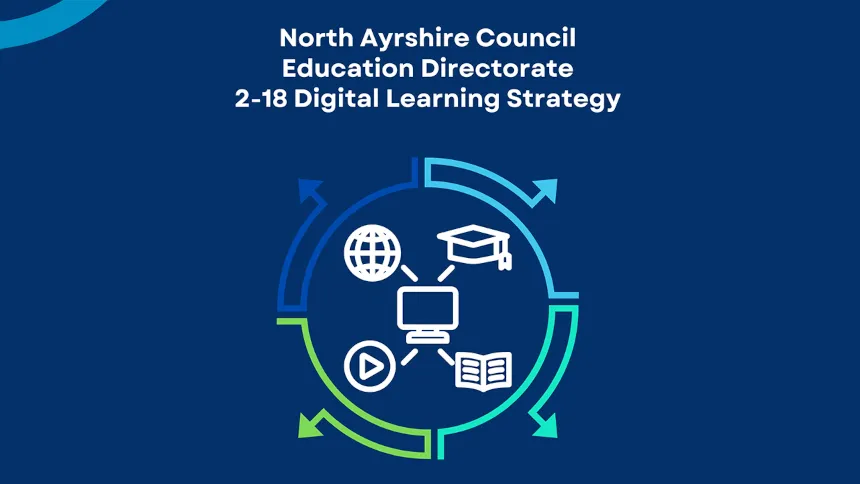
The NAC Education Service’s Digital Learning Strategy was launched in March 2025 following successful collaborative work of the Digital Service Improvement Group, a group consisting of highly experienced practitioners from across all sectors with responsibility for delivery of the curriculum from 2-18.
The Digital Learning Strategy aims to:
- develop learners’ digital skills and prepare them for life in an increasingly complex world;
- ensure that our practitioners are able to use a range of digital technologies confidently and appropriately to deliver exciting, supportive, relevant and engaging learning experiences;
- support our establishments in achieving strong outcomes in external evaluations.
There are four main areas within the strategy as outlined below:
- the vision and aims of the strategy (linked to high quality learning experiences for all children and young people in NAC)
- the digital skills our children and young people need for learning, life and work (progression tables for each skill)
- the digital skills our practitioners require to ensure our learners’ digital needs are met (progression tables for each skill)
- tools and training, as well as examples of good practice at local and national levels
Following a successful pilot, the expectation is that all educational establishments will adopt the strategy from session 2025-26 onwards as part of their raising attainment approaches and across 2025-26 the strategy will become embedded across establishments, from Early Years through to Senior Phase.
Underpinning this strategy are the digital skills of our practitioners. Our digital learning offer in 2024-25, delivered by the Digital Development Officer, has resulted in the following:
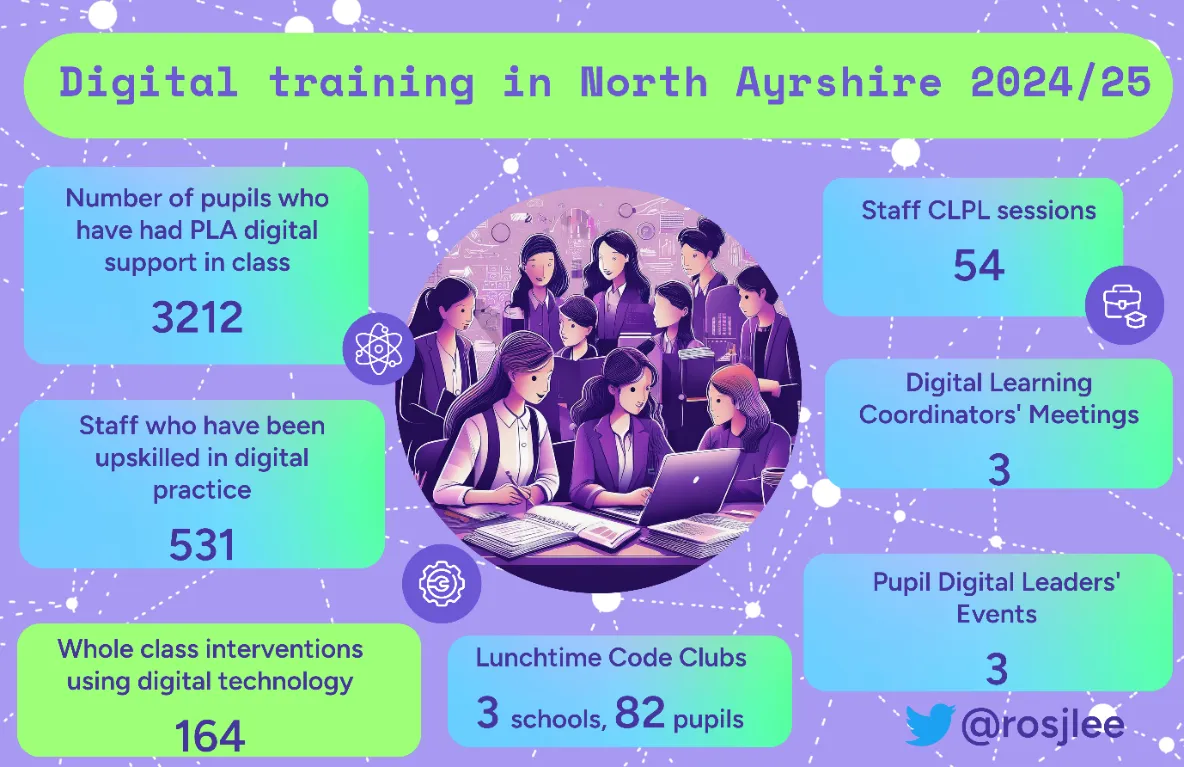
Theme two: Raising attainment and acheivement
The creation of a new raising attainment strategy
With the launch of a new data visualisation tool, schools were further supported to track and analyse the progress in learning across all stages of the Broad General Education for the literacy organisers and numeracy. Aligned with this, data clinics were held with primary and secondary senior leaders to support data literacy skills for school improvement, including the use of attendance data.

The creation and activity of a data Service Improvement Group has also further helped to ensure effective use of data to track and monitor learners’ progress in literacy and numeracy and will take forward the use of data analysis tools in 2025-26. In addition to the improved use of data at school and establishment level, the ability to capture data for analysis centrally in literacy and numeracy in the BGE helped to identify areas for targeted support and priorities for session 2025-26.
In the secondary sector, data sessions with heads of faculty for English and maths and networks for depute head teachers allowed staff to develop their understanding of data for improvement and promoted collegiate collaborative working.
Taken together, these actions are key components of the emerging raising attainment strategy, which will be completed in session 2025-26.
Enhanced approaches to tracking and target setting
Early years and primary senior leaders collaborated across the year to produce a range of exemplar materials for tracking and monitoring literacy and numeracy. Cross-sector working also allowed for the development of a consistent approach and commitment to the tracking and monitoring of both areas.
The core and additional stretch aims for early years, primary and secondary were highlighted regularly with senior and middle leaders and allowed for professional discussion and self-evaluation. Secondary attainment dialogues across the nine secondary senior leadership teams provided an opportunity to analyse attainment data and targets for session 2024-2025.
Deploying additional teaching staff to support raising attainment
In a number of primary schools, raising attainment class teachers continued to use data to identify groups of learners to target for specific learning and teaching interventions. By providing appropriate pace and challenge, the raising attainment teachers could support the work of the class teachers and enhance the learning experiences to ensure better outcomes for identified learners.
A focus on stretch aims across all sectors at establishment and local authority levels provided opportunity for regular data analysis and professional dialogue around attainment of learners in North Ayrshire schools and early years establishments. This has led to a clear set of improvement actions to take forward into session 2025-2026.
Performance Indicators for Priority One
Inspection Outcomes
The improvement activities under Priority one are designed to have a positive impact on the quality of learning, teaching and assessment and attainment outcomes. A strong external indicator of the quality of educational provision overall is the percentage of school/ early learning and childcare inspections by Education Scotland which resulted in an evaluation of “good” or better. Data has been analysed since the introduction of the current inspection framework in 2016 until 2024. In the tables below, there are consistently strong performances across all quality indicators, and particularly in the areas of learning, teaching and assessment as well as raising attainment and achievement/securing children’s progress.
* Data source = internal analysis of inspections published on Education Scotland website.
| Quality Indicator | NAC 2016-2024* | National 2016-2024* |
|---|---|---|
| Leadership of change | 85% | 62% |
| Learning, teaching and assessment | 81% | 63% |
| Ensuring wellbeing, equality and inclusion | 85% | 69% |
| Raising attainment and achievement | 77% | 62% |
| Quality Indicator | NAC 2016-2024* | National 2016-2024* |
|---|---|---|
| Leadership of change | 80% | 60% |
| Learning, teaching and assessment | 88% | 63% |
| Ensuring wellbeing, equality and inclusion | 80% | 75% |
| Securing children’s progress | 88% | 68% |
North Ayrshire Early Learning Milestones
Overall, children continue to reach their early learning milestones in significant numbers by the start of Primary one. The percentage of children in 2023-2024 who successfully achieved their early learning milestones across all measures (literacy, numeracy and health & wellbeing) is 79%. Whilst this is slightly lower than the previous year, this figure is the joint second highest level of achievement in the last five years. To ensure alignment across the early level, there are plans to replace this performance indicator next year with one which focuses exclusively on early level curriculum for excellence benchmarks.
Achievement of Curriculum for Excellence Levels
In 2024, 69% of primary aged children in North Ayrshire Council achieved the appropriate attainment level in Literacy. This is one percentage point higher than in 2023. To illustrate the significant impact that Covid had on our learners’ attainment and track our gradual recovery since then, our 2024 performance is ten percentage points higher than in 2021. In Numeracy, 76% of primary aged children in North Ayrshire Council achieved the appropriate attainment level in 2024, which is in line with the performance in 2023 and is nine percentage points higher than in 2021. North Ayrshire’s performance has remained lower than the national picture since Covid.
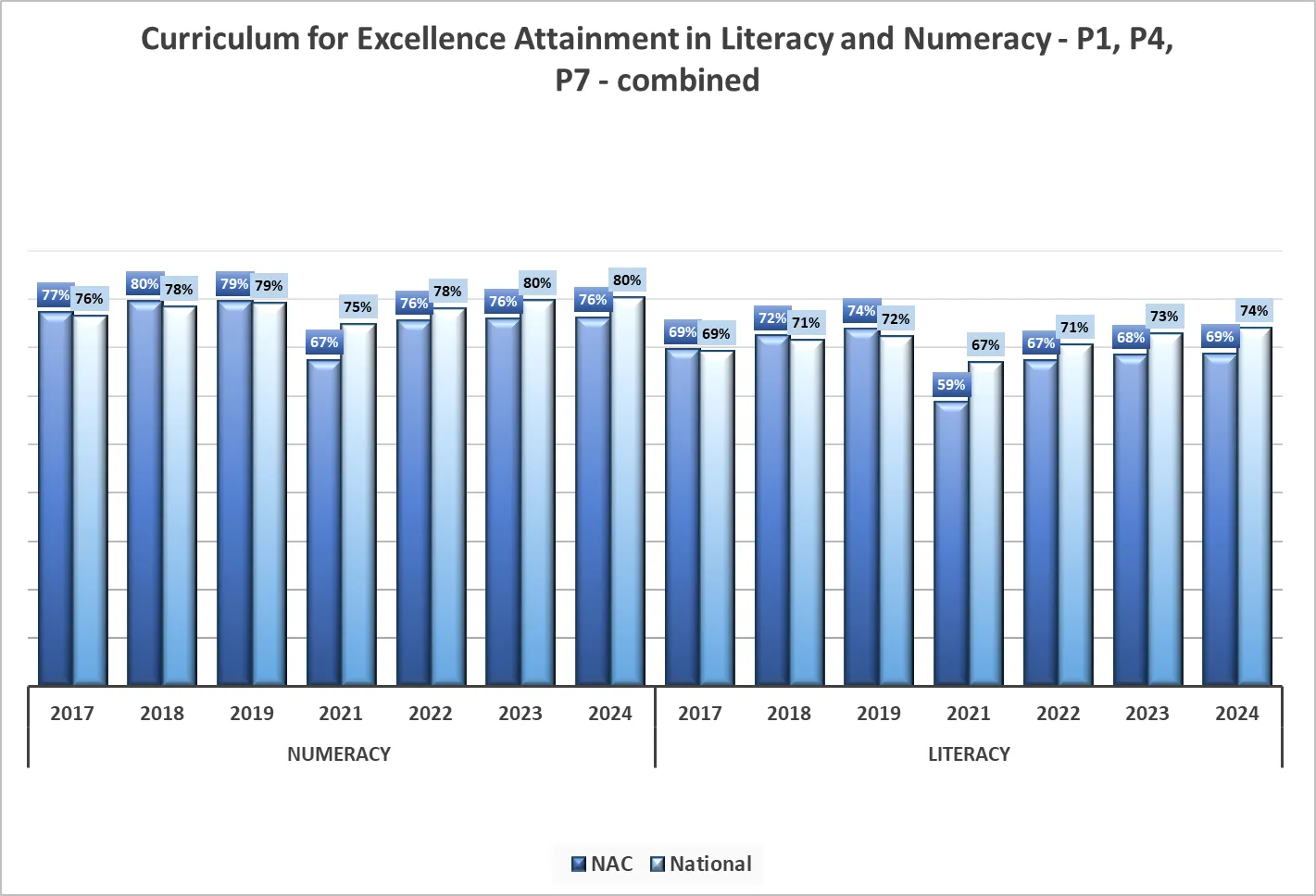
Overall attainment data over time suggests that local authorities with the highest levels of poverty / deprivation generally experienced a steeper drop in primary school attainment during Covid and a slower rate of recovery to pre-pandemic levels compared to the rest of the country.
Improving leavers’ attainment in literacy and numeracy
In 2024, just over 93% of North Ayrshire’s school leavers achieved level four literacy or better. This is in line with the national figure, and while this is a slight reduction on previous years (similar to the national trend), it remains above the virtual comparator performance, and has done so for more than five years. Similarly, at level five, North Ayrshire leavers outperformed all other comparators except the national figure (which is equal to NAC performance), with just over 81% achieving literacy at level five or better.
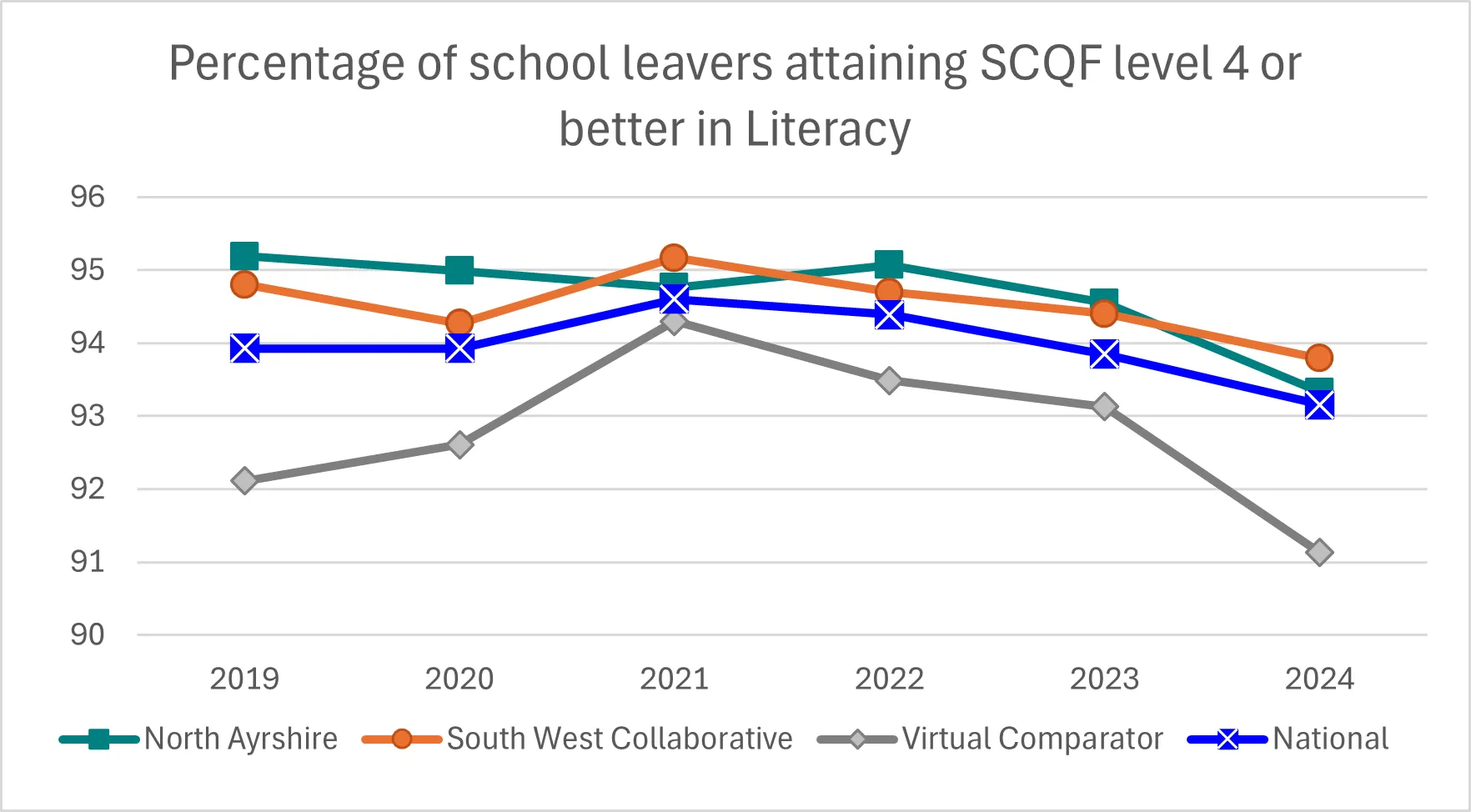
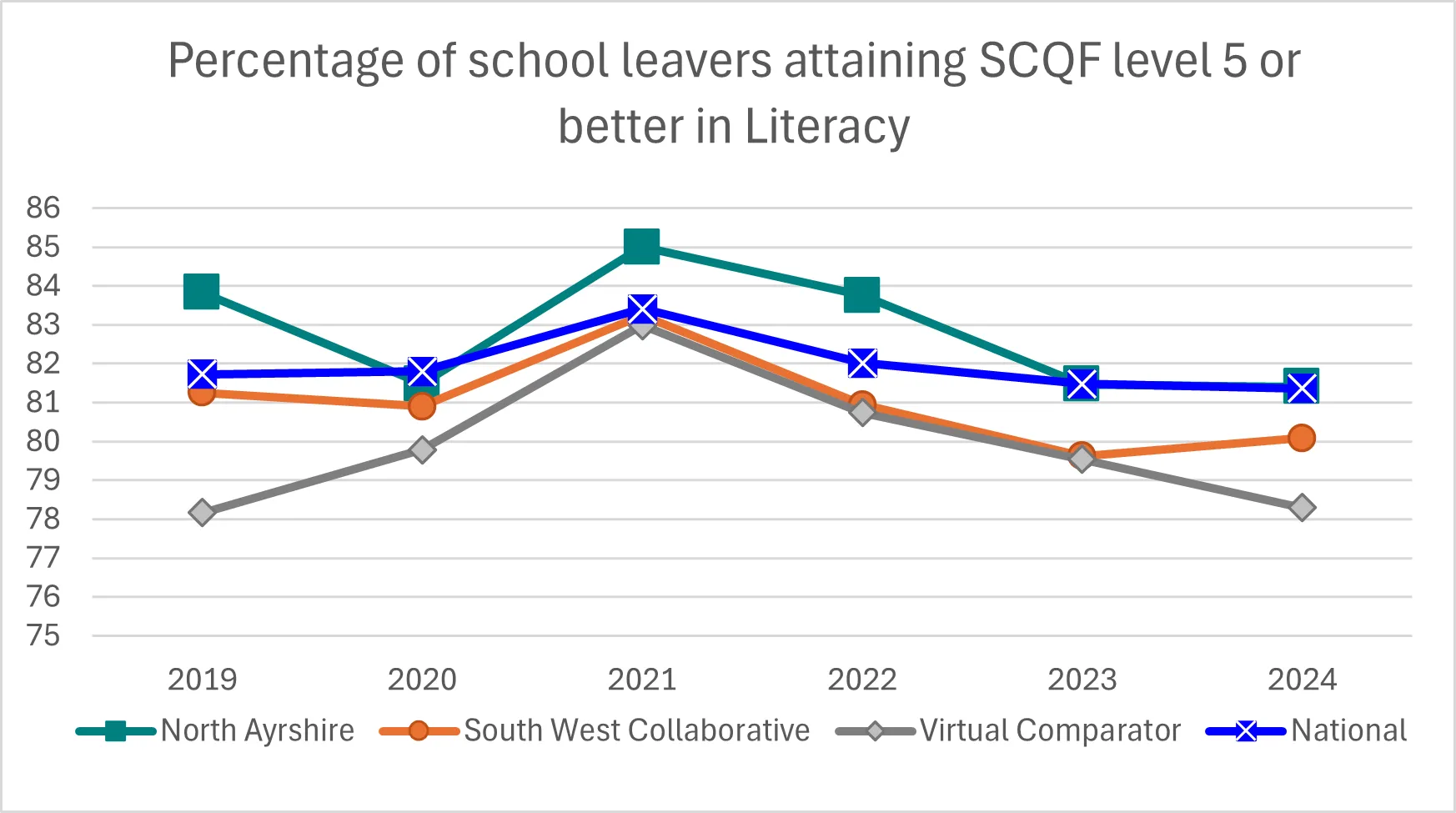
The performance of North Ayrshire school leavers in attaining numeracy at levels four and five has fluctuated slightly over the 5-year period, with our schools again remaining above the Virtual Comparator in almost all years. In 2024, 90% of school leavers in North Ayrshire achieved level four numeracy, which is again in line with the national figure and above the virtual comparator. In 2024, 71% of school leavers attained level five numeracy, just slightly below the national figure of 72%, but three percentage points better than the previous year. For more than five years, North Ayrshire’s performance at level five numeracy has been consistently above the virtual comparator of pupils across the rest of the country with similar characteristics.
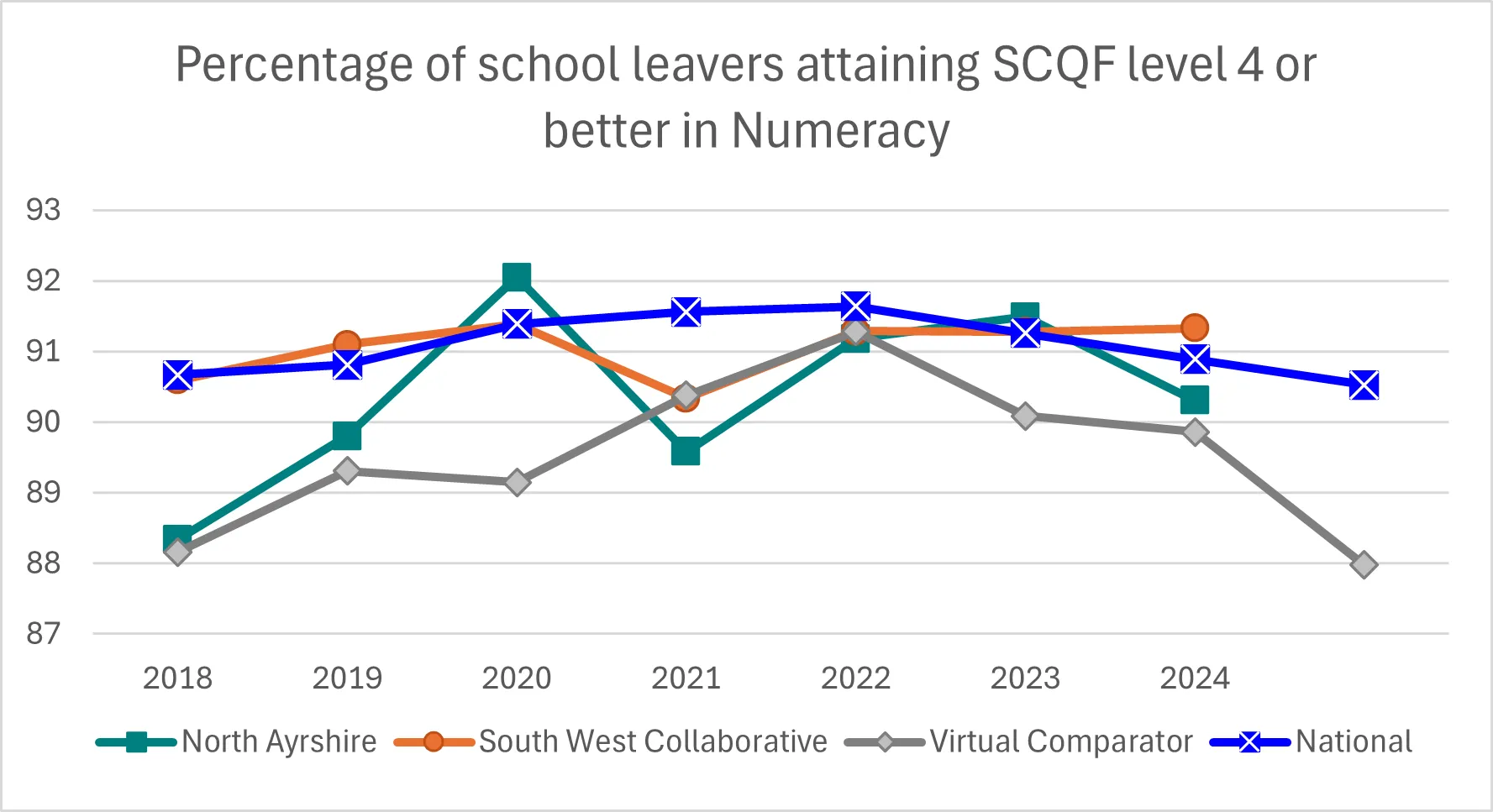
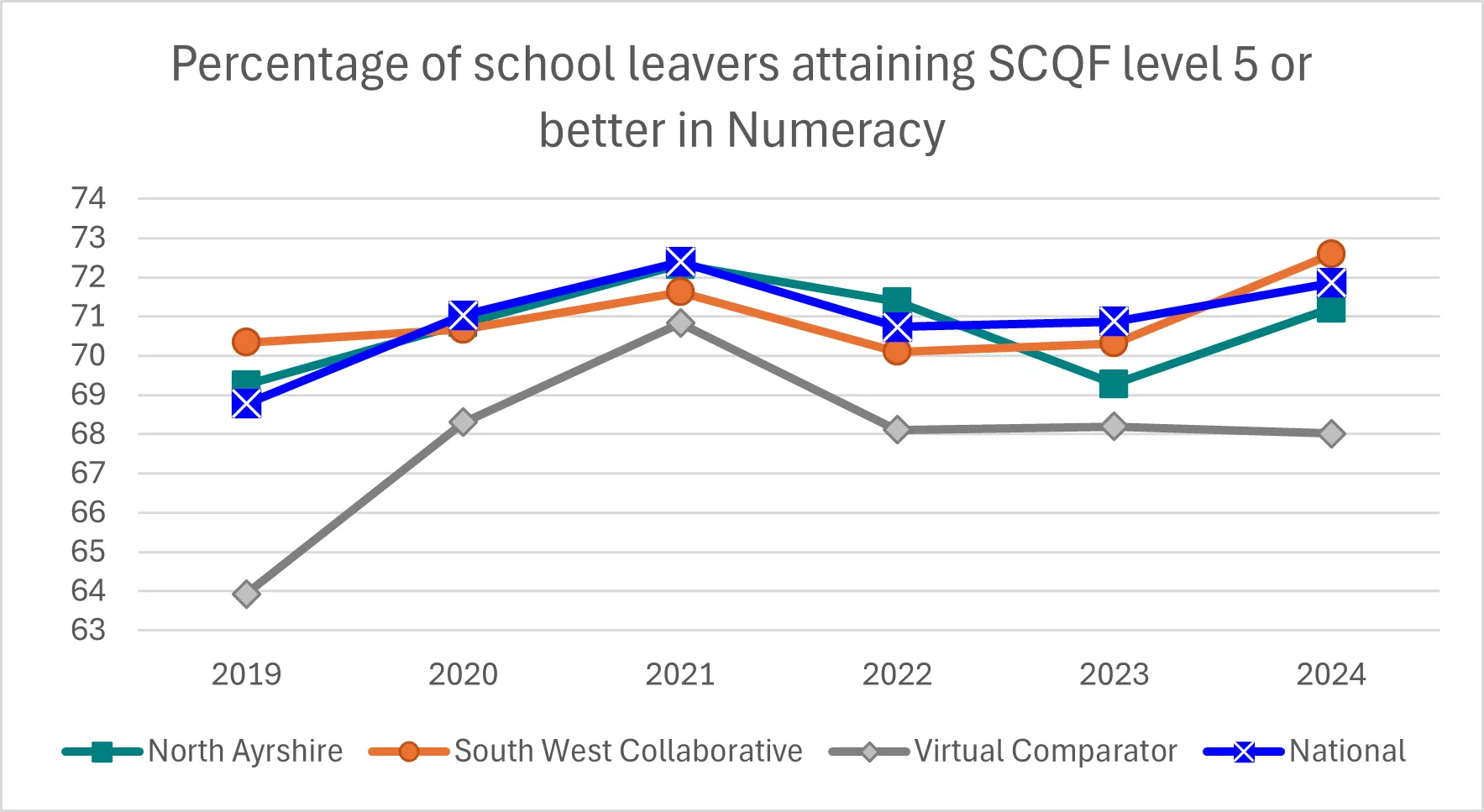
Improving attainment for all
This measure focuses on the average total tariff score of the candidate’s latest and best qualifications. Tariff points are assigned to each unit or course achieved by learners – in all Scottish Credit and Qualifications Framework (SCQF) -graded awards, not just those provided by SQA. This acknowledges to a greater extent the drive towards wider achievement qualifications and encourages schools to offer curricular choices and learner pathways tailored to a variety of abilities and aspirations.
In 2024, the average total tariff score for the lowest attaining 20% of learners is above the Virtual Comparator and broadly in line with the national figure.
The average total tariff score of the middle attaining 60% of leavers is broadly in line with the Virtual Comparator, but below the national figure. The average total tariff score of the highest attaining 20% of leavers is almost the same as the previous year. The NAC figure has been above the Virtual Comparator for the last three years.
| 2023-24 | 2022-23 | 2021-22 | 2020-21 | 2019-20 | |||||||||||
|---|---|---|---|---|---|---|---|---|---|---|---|---|---|---|---|
| NAC | VC | Scot | NAC | VC | Scot | NAC | VC | Scot | NAC | VC | Scot | NAC | VC | Scot | |
| Lowest 20% | 123 | 100 | 129 | 133 | 127 | 141 | 155 | 140 | 154 | 160 | 157 | 164 | 139 | 126 | 151 |
| Middle 60% | 738 | 749 | 841 | 744 | 766 | 832 | 812 | 804 | 871 | 840 | 873 | 939 | 780 | 821 | 880 |
| Highest 20% | 1865 | 1840 | 1928 | 1869 | 1866 | 1931 | 1907 | 1876 | 1950 | 1860 | 1910 | 1982 | 1797 | 1865 | 1921 |
The average complementary tariff scores are calculated using the same principles but display the average tariff score for only the five best qualifications achieved per candidate. Visit the following link for further information about tariff points.
| 2023-24 | 2022-23 | 2021-22 | 2020-21 | 2019-20 | |||||||||||
|---|---|---|---|---|---|---|---|---|---|---|---|---|---|---|---|
| NAC | VC | Scot | NAC | VC | Scot | NAC | VC | Scot | NAC | VC | Scot | NAC | VC | Scot | |
| Lowest 20% | 113 | 93 | 118 | 125 | 116 | 127 | 137 | 126 | 137 | 141 | 137 | 144 | 126 | 114 | 133 |
| Middle 60% | 545 | 551 | 610 | 554 | 570 | 612 | 607 | 600 | 643 | 643 | 649 | 691 | 611 | 616 | 657 |
| Highest 20% | 1195 | 1203 | 1269 | 1204 | 1237 | 1286 | 1256 | 1253 | 1304 | 1254 | 1284 | 1339 | 1256 | 1272 | 1314 |
Breadth and Depth
Breadth and depth measures highlight that North Ayrshire’s school leaver attainment performance in 2024 is broadly in line with both the South West Educational Improvement Collaborative (SWEIC) and national performance, but higher than the virtual comparator. In 2024 North Ayrshire leavers generally performed slightly better than in 2023, and outperformed other comparators in the measure of five or more qualifications at level three and one or more qualifications at level six.
| 2024 | 2023 | 2022 | 2021 | 2020 | 2019 | |
|---|---|---|---|---|---|---|
| National | 88.0% | 88.6% | 90.1% | 90.5% | 89.6% | 89.0% |
| North Ayrshire | 89.9% | 88.6% | 91.2% | 91.0% | 90.0% | 89.4% |
| Virtual Comparator | 86.0% | 88.1% | 89.2% | 90.5% | 88.3% | 86.8% |
| SWEIC | 89.3% | 89.5% | 90.5% | 90.8% | 89.9% | 89.8% |
| 2024 | 2023 | 2022 | 2021 | 2020 | 2019 | |
|---|---|---|---|---|---|---|
| National | 84.2% | 85.1% | 86.5% | 87.1% | 85.8% | 85.4% |
| North Ayrshire | 83.4% | 82.9% | 86.5% | 85.8% | 84.3% | 83.6% |
| Virtual Comparator | 81.3% | 83.9% | 85.2% | 86.9% | 83.7% | 82.7% |
| SWEIC | 84.5% | 85.1% | 86.3% | 87.0% | 85.4% | 85.4% |
| 2024 | 2023 | 2022 | 2021 | 2020 | 2019 | |
|---|---|---|---|---|---|---|
| National | 66.6% | 66.3% | 67.7% | 70.5% | 67.5% | 64.3% |
| North Ayrshire | 64.8% | 63.4% | 67.0% | 69.6% | 65.3% | 60.7% |
| Virtual Comparator | 62.5% | 63.2% | 65.1% | 68.8% | 64.6% | 59.9% |
| SWEIC | 64.9% | 63.9% | 66.3% | 69.0% | 66.4% | 63.5% |
| 2024 | 2023 | 2022 | 2021 | 2020 | 2019 | |
|---|---|---|---|---|---|---|
| National | 66.5% | 65.6% | 67.1% | 70.2% | 68.2% | 66.2% |
| North Ayrshire | 67.8% | 66.2% | 68.0% | 70.6% | 67.3% | 65.0% |
| Virtual Comparator | 64.0% | 63.2% | 65.2% | 69.4% | 65.9% | 62.6% |
| SWEIC | 63.2% | 61.9% | 65.1% | 68.6% | 65.8% | 64.0% |
| 2024 | 2023 | 2022 | 2021 | 2020 | 2019 | |
|---|---|---|---|---|---|---|
| National | 51.7% | 51.1% | 53.0% | 56.6% | 54.7% | 50.9% |
| North Ayrshire | 48.9% | 49.2% | 51.0% | 53.8% | 51.7% | 44.4% |
| Virtual Comparator | 47.3% | 47.6% | 49.6% | 53.4% | 51.5% | 46.0% |
| SWEIC | 48.7% | 48.3% | 50.7% | 53.9% | 51.9% | 47.5% |
| 2024 | 2023 | 2022 | 2021 | 2020 | 2019 | |
|---|---|---|---|---|---|---|
| National | 39.0% | 37.9% | 38.7% | 42.1% | 40.2% | 36.0% |
| North Ayrshire | 36.2% | 35.0% | 36.1% | 37.6% | 35.6% | 28.3% |
| Virtual Comparator | 33.8% | 35.4% | 34.8% | 37.7% | 37.0% | 31.2% |
| SWEIC | 35.7% | 35.5% | 35.9% | 38.5% | 36.3% | 32.7% |
| 2024 | 2023 | 2022 | 2021 | 2020 | 2019 | |
|---|---|---|---|---|---|---|
| National | 25.4% | 25.4% | 26.0% | 28.0% | 25.6% | 22.1% |
| North Ayrshire | 21.9% | 20.5% | 24.7% | 23.9% | 23.5% | 18.0% |
| Virtual Comparator | 21.6% | 23.1% | 23.0% | 25.0% | 23.1% | 18.5% |
| SWEIC | 22.3% | 23.2% | 24.5% | 24.9% | 23.5% | 20.0% |
Education Service Priority Two
Closing the attainment gap between the most and least disadvantaged children and young people.
Theme one: Interventions to close gaps
Reducing the gap in early years
Access to highly qualified practitioners with expertise in early childhood learning and development plays a key role in realising our ambitions for our youngest children. This is particularly true for young children who face the greatest disadvantages, where additional support may be required to ensure equity of outcomes.
Scottish Government provided funding to North Ayrshire targeted at reducing the poverty-related attainment gap in Early Years.
In North Ayrshire we have appointed 21 Equity and Excellence Leads who are professionals in early learning and childcare settings and whose role is to support closing the attainment gap between the most and least advantaged children. They achieve this by providing additional support to children who need it most, working directly with families, and upskilling other practitioners.
Their key responsibilities include:
- focusing on providing increased expertise in early childhood learning and development to children facing disadvantages.
- modelling best practices and support other practitioners in improving their pedagogical approaches.
- Working directly with families to build strong relationships and promote engagement in their children's learning.
- Working to reduce the achievement gap in areas like literacy and numeracy to promote positive outcomes for all children.
In practice, our Excellence and Equity Leads create increased opportunities for flexible approaches and more dedicated time for supporting other Early Years staff in helping to reduce the poverty-related attainment gap and providing focused support to identified children and families.
Pupil Equity Funding Case Studies
Pupil Equity Funding (PEF) is additional funding allocated directly to schools and targeted at closing the poverty-related attainment gap. This investment is part of the Scottish Attainment Challenge programme and empowers head teachers to improve outcomes for children and young people impacted by poverty. North Ayrshire schools are directly allocated a share of almost £4.2 million in PEF funding annually until 2026. Details about the funding levels allocated to individual schools can be found on the Scottish Government website.
For session 2024-25, school PEF plans and impact reports have been reviewed resulting in key strengths and improvement areas being identified. The review of plans indicates that almost all schools have a clear and robust rationale for school improvement priorities. Almost all schools are able to provide examples of effective PEF interventions supporting improvement for all targeted learners.
All schools work with their school community to decide how to invest PEF and are encouraged to use participatory budgeting approaches to inform decision making. There is a strong focus on learner participation, recognising the importance of actively involving children and young people in decision making processes, including those pupils from disadvantaged backgrounds.
The following brief case studies illustrate how schools are using Pupil Equity Funding effectively to reduce gaps with targeted groups of learners.
PEF Case Study One – Stanley Primary School
To increase attendance, support inclusion and provide opportunities to engage in wider achievement experiences.
Rationale
- Improve pupil attendance at school by providing a breakfast club, monitoring and comparing with a target group of learners.
- Support inclusion by providing a soft start to targeted regular late-coming pupil or those who arrive at school dysregulated.
- Develop opportunities for wider achievement for all learners, it has removed the financial worry of at least 57% of families who would have not been able to pay costs for the exciting and ambitious activities on offer.
Description
- Employment of additional staffing to run the breakfast provision, three Pupil Support Assistants and one Healthy Start Worker.
- Staff provide supervision, a nutritious healthy breakfast and engaging fun activities from eight o’clock to nine o’clock each morning.
- Children who require a soft start to the day or who were regularly late to school were invited to Breakfast Club.
- All children from P1-P7 will have dedicated opportunities for wider achievement, P1-3 Forest Schools/ P4 & P5 skiing/ P6 swimming/P7 subsidised residential to Arran.
Breakfast club provision:
Support Inclusion:
Develop opportunities for wider achievement for all learners:
Impact of initiatives
- In 2024- 25 whole school attendance levels have improved by two percentage points from 90% to 92%. Each day, on average 80 pupils attend the breakfast club, this has had a positive impact on reducing late coming.
- The average increase in attendance of the target group of 17 pupils in Scottish Index of Multiple Deprivation (SIMD) one and two was six percentage points.
- Across all stages teachers reported in their evaluations of learning and teaching that all children showed improved readiness for learning. Most staff independently commented that this was a result of engaging in Breakfast Club.
- Our wider achievement tracker evidences that all pupils at Stanley Primary have the opportunity to experience wider achievement in at least one extra-curricular area.
Breakfast club provision:
Support Inclusion:
Develop opportunities for wider achievement for all learners:
PEF Case Study Two – Irvine Royal Academy: where cost is never a barrier to opportunity
Rationale
- To ensure financial constraints never stand in the way of pupils’ success and wellbeing through Cost of the School Day (COSD).
- Developing the Young Workforce (DYW), supporting positive destinations for all students by engaging employers, providing career opportunities and guidance, and building partnerships.
To remove barriers created by financial limitations and support the development of skills for life, learning and work.
Description
We introduced a free Royal Resources Shop and established a Cost of the School Day group; both aimed at reducing the stigma of poverty by providing essential items and support to all pupils. The intention was to create a more inclusive and equitable school environment where all pupils have equal opportunities.
Employment of Principal Teacher for DYW to facilitate engagement of employers and provide opportunities that support pupils for when they leave school – this ranges from site visits, careers talks and marketplace events, supporting university and college applicants, raising awareness of available pathways and connecting education staff to employers through the creation and maintenance of partnerships. The ultimate aim is to support positive destinations for all leavers
Impact of COSD
We measured impact through data and feedback. The Cost of the School Day group and the Royal Resources Shop help reduce inequity by ensuring all pupils have access to essential items like uniforms, food, toiletries, and digital devices, removing barriers that can negatively impact learning and attendance. By reducing financial stress on families and promoting dignity through discreet, stigma-free support, pupils are more likely to attend school regularly, feel included, and fully engage in their education.
Impact of employing Principal Teacher for DYW
We have been above our virtual comparator for positive destination for the previous three years. UCAS applications for 24/25 have secured the following offers, 23 unconditional, 45 conditional and 7 unsuccessful. Pupils from S3-S6 were offered engagements with FOCUS West team, feedback very positive. These pupils are offered opportunities based on the following criteria: SIMD 1-3, being care-experienced, a young carer, an asylum seeker or having refugee status. Engagements and opportunities created for these pupils are successfully supporting them to transition into higher education after leaving school.
Theme two: Specific focus on identified target groups, including care experienced learners
Care experienced children and young people continue to be supported through a range of interventions where the focus is on delivering equity and improving educational outcomes.
MCR Pathways: North Ayrshire’s Young Talent programme
Motivation, Commitment and Resilience (MCR) Pathways has been operating in North Ayrshire since 2018 and has supported hundreds of young people through personalised relationship-based mentoring. Pathways Coordinators work in partnership with participating schools to guide and help young people into mentoring and support them as they develop their mentoring and school journey. They work closely with the wider schools team, Developing the Young Workforce (DYW) Staff and Skills Development Scotland (SDS) staff in order to provide holistic support for the young people we work with.
Mentoring begins in S3 when a young person is matched with a volunteer mentor who they meet weekly in school. Group work is led by the Pathways Coordinator who delivers centrally planned sessions focused on themes: Getting to Know You, Health and Wellbeing, Relationship and Team Building, Resilience, Skills for Life and Work, Community and preparing for Mentoring.
During the last academic session, over 3,600 meetings took place between young people and their mentors. This is an increase of almost 1,000 on the previous year’s figures. In total, 451 young people were supported by the MCR programme across North Ayrshire. Of this number, 262 young people had an active mentoring arrangement, a further 158 were engaged in group work and 31 were supported directly through individualised interventions by their Pathways Coordinator.
Case Study: Shannon and Julie (names changed) - Garnock Community Campus
Shannon and her mentor Julie have been meeting regularly for over two and a half years. When Shannon was first introduced to the programme, she lacked confidence and struggled with low self-esteem. She openly shared her experiences of past trauma and the difficulty she had in trusting others. She also spoke about the challenges of managing stress and anciety, and not having someone at home she felt she could talk to.
It was clear that Shannon needed a mentor who not only shared her interests but also understood the importance of emotional wellbeing. Julie, with her warm and supporting nature, was a perfect match. She brought a strong understanding of mental health, alongside a creative flair that mirrored Shannon's own passions.
From their very first meeting, the connection between them was instant. Their shared personality traits and interests helped their relationship grow quickly. One of their early projects together was focused on supporting Shannon through her Duke of Edinburgh Award. Julie taught her how to sew on a machine. Together they created a cushion and she also helped Shannon find local volunteering opportunities. These achievements boosted Shannon's sense of accomplishment and pride.
As their mentoring relationship deepened, so did their trust. Shannon began to open up more about her life, and Julie became a consistent, compassionate presence.
As Shannon approached the end of school, their focus turned to future pathways. Julie supported her in exploring college options, completing applications, and preparing for interviews. Shannon's efforts were rewarded with an unconditional offer to study First Steps to Councelling and Mental Health at Ayrshire College.
Reflecting on Shannon's journey, the change is remarkable. She has grown into a confident, capable young woman who now sees herself and her future with hope and clarity.
Keeping The Promise Education Award Programme
This professional learning has been created to support anyone working with children and young people particularly those who are care experienced. The aims of the programme are to:
- raise awareness and understanding of The Promise (which is the commitment made both locally and nationally to improving the experiences and outcomes for Scotland’s care experienced children and young people), and our responsibilities as corporate parents
- help practitioners understand the needs of children and young people and what we can do to support them
Participation in the Award is recognised at both personal and establishment levels through the ‘I Promise’ and ‘We Promise’ Certificates. A final ‘Keeping the Promise’ Award will be issued to establishments who can evidence impact of the professional learning on educational outcomes for care experienced children and young people. To date we have three Secondary Schools who have completed the full Award: Auchenharvie, Academy, St Matthew’s Academy and Irvine Royal Academy, where the initial whole school presentation was delivered in partnership with the MCR Pathways coordinator. Care Experienced Learners were asked their views of what Keeping The Promise meant to them, and these were shared with staff. Staff described this as “eye opening” and that it was particularly impactful to hear about the preferred language around Care Experience that the young people described. Staff reported increased confidence in their ability to support Care Experienced Learners. Additional schools are at various stages of progress through the learning.
Secondary schools have an identified The Promise champion who attends a network to share information around supporting others to understand their role as a corporate parent.
Performance Indicators for Priority Two
Early Learning Milestones attainment gap
The gap between the percentage of children living in the most and least deprived areas who achieve their early learning milestones has fluctuated across recent years, with the largest gap in the year immediately following the pandemic. In the most recent year with published data, the gap has narrowed slightly, but this remains an area for further improvement in future.
Primary attainment gap (P1, P4, P7 combined Curriculum for Excellence Levels)
Primary literacy and numeracy attainment gaps within the Broad General Education (BGE) have returned to a similar size and pattern to the pre-Covid period, however, work is ongoing to improve the overall attainment levels of all groups to firstly recover to pre-pandemic levels then build on these. Nevertheless, the improvements so far since the pandemic have been steeper for those facing the highest levels of deprivation (according to SIMD), with an improvement in literacy of 13 percentage points for this group since 2020-21, compared to an improvement of seven percentage points for the least deprived group. There is a similar picture for improvements in numeracy, with an improvement of twelve percentage points for the most deprived group since 2020-21, compared to an improvement of six percentage points for the least deprived group.
School Leavers Attainment Gap (Breadth and Depth)
In 2023-24, 82% of the most deprived group of school leavers in North Ayrshire, for example those living in Scottish Index of Multiple Deprivation (SIMD) Quintile 1, left school with at least one qualification at SCQF Level 5 or better. This is significantly above the national figure of 78% for this group. North Ayrshire SIMD Quintile 1 school leavers have performed better than the equivalent national cohort every year since 2017.
For comparison, the table below shows NAC and Scotland percentages of leavers living in SIMD Quintile one with at least one award at SCQF Level five (all awards) or better over the last eight years.
| 2024 | 2023 | 2022 | 2021 | 2020 | 2019 | 2018 | 2017 | |
|---|---|---|---|---|---|---|---|---|
| NAC Quintile 1 | 81.6% | 84.4% | 82.2% | 83.3% | 79.1% | 79.6% | 82.3% | 78.7% |
| Scotland Quintile 1 | 78.0% | 79.3% | 80.2% | 80.6% | 78.0% | 78.9% | 78.1% | 78.1% |
In 2023-24, just under 58% of the most deprived group of school leavers (i.e. those living in SIMD Quintile one) left school with at least one qualification at SCQF Level six or better. This is the second best performance for this group in the last few years, and is also significantly higher than the equivalent national figure of 52%.
For comparison, the table below shows NAC and Scotland percentages of leavers living in SIMD Quintile one with at least one award at SCQF Level six (all awards) or better over the last eight years.
| 2024 | 2023 | 2022 | 2021 | 2020 | 2019 | 2018 | 2017 | |
|---|---|---|---|---|---|---|---|---|
| NAC Quintile 1 | 57.6% | 57.3% | 55.9% | 60.6% | 55.0% | 51.9% | 52.7% | 45.9% |
| Scotland Quintile 1 | 52.2% | 51.5% | 51.9% | 54.9% | 52.2% | 50.6% | 49.4% | 47.6% |
Care Experienced Leavers educational outcomes
In North Ayrshire we count all children and young people as “care experienced” if they are currently looked after at home, away from home or if they have ever been looked after at any point in the past.
In 2023-2024, 85% of North Ayrshire’s care experienced school leavers attained at least one qualification at SCQF level four or better. For level five, 63% of care experienced leavers achieved at least one qualification, the second highest performance in the last five years. In 2023-2024, 34% of care experienced school leavers in North Ayrshire left with at least one qualification at SCQF level six or better. At all levels, North Ayrshire’s performance compares positively with the national picture, although there is a continued focus on securing further improvements. The national report on Educational Outcomes for Looked After Children does not publish attainment data for all care experienced learners, focusing instead on those who were “looked after” in that year. In the charts below, North Ayrshire’s Care Experienced outcomes as well as North Ayrshire’s Looked After outcomes are displayed, in order to be able to benchmark the data against the available national level statistics.
Education Service Priority Three
Improvement in skills and sustained, positive school leaver destinations for all young people
Theme one: Improved skills
Increasing curricular links to the Ayrshire Growth Deal
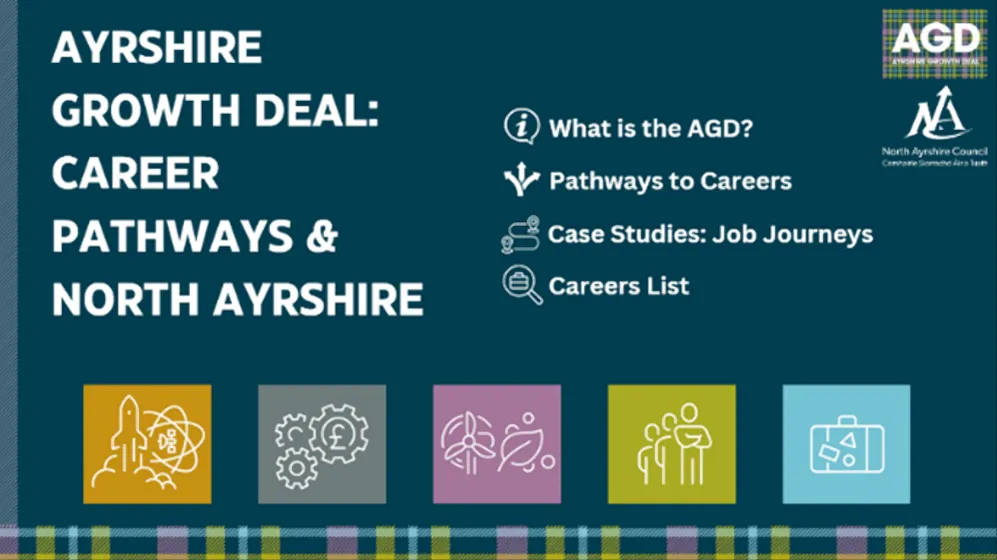
In order to align the development of skills required for positive, sustained post-school destinations, a tool has been created for learners, school staff and families which provides a visualisation of the Ayrshire Growth Deal areas:
- Aerospace and space innovation
- Economic infrastructure
- Energy, circular economy and environment
- Tourism
- Communities
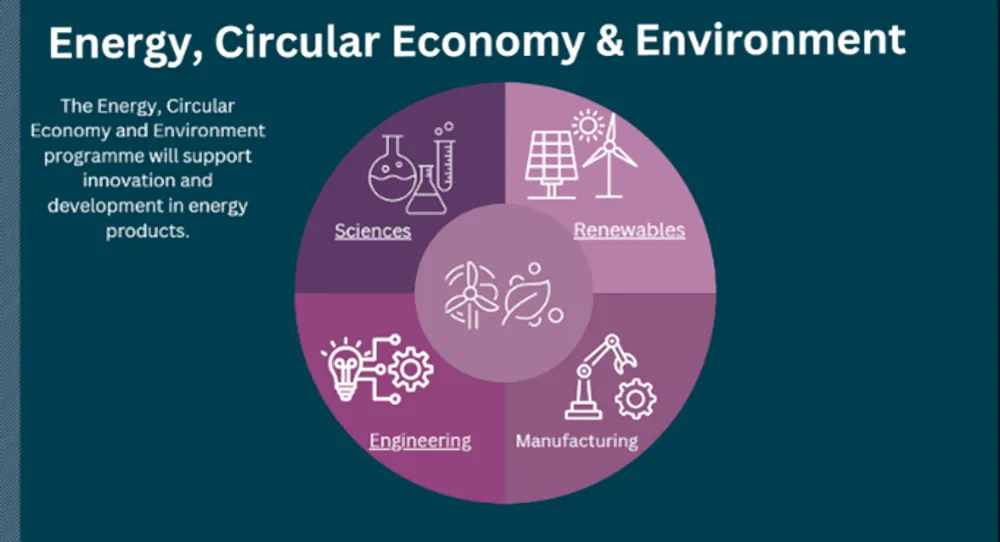
The tool helps learners to identify the skills, qualifications and experience needed for identified careers linked to the Ayrshire Growth Deal areas. With increasing employment and career opportunities within the areas of, for example, energy and aerospace, NAC Education and Ayrshire College worked collaboratively across the academic session to plan for the co-delivery of the Performing Engineering Operations course at SCQF level five. The new joint delivery model will be introduced in session 2025-2026 with this course shared between North Ayrshire Education Service and Ayrshire College.
Curriculum Review
During 2024–25, Head Teachers were kept up to date on Education Scotland’s Curriculum Improvement Cycle (CIC) through regular briefings and discussions. Updates focused on national developments in curriculum design, including changes to frameworks, new approaches to learner progression, and the introduction of ideas such as the “Know-Do-Understand” model. Different curriculum typologies were explored to support broader thinking around school-level implementation. Revised guidance and exemplification materials developed through CIC were highlighted to help leadership teams prepare and align future planning.
Colleagues from across NAC establishments are increasingly involved in the national curriculum improvement cycles, supporting work at national level on curriculum reviews, and further specific work on refreshing our curriculum will take place in session 2025-26.
Performance Indicators for Priority Three
School Leavers entering an initial positive destination
An initial positive destination means that a school leaver has gone on to one of the following activities immediately after leaving school: further or higher education, training, skills development or employment. At 95.6%, the proportion of leavers in North Ayrshire moving into an initial positive destination in 2023-2024 has again exceeded the virtual comparator for the fifth year in a row and is in line with the national figure. To maximise the percentage of school leavers entering and sustaining positive destinations, schools continue to work hard in strong partnership with Skills Development Scotland.
The Annual Participation Measure for all 16-19 year-olds
The Annual Participation Measure (APM) is a measurement of the proportion of 16-19-year-olds participating in education, training or employment over a whole year (1 April-31 March). The indicator provides a measure of the status of the wider aged 16-19 cohort – not just those who have left school. The Annual Participation Measure, covering the year from April 2023 – March 2024 showed that of the 5,990 16-19-year-olds in North Ayrshire, 91.7% were in education, employment or training and personal development. This is the second highest figure on record since the APM started in 2016.
Education Service Priority Four
Improvement in children and young people's health and wellbeing
Theme one: Supporting mental health and wellbeing
Whole school and community approaches to supporting children’s mental health and wellbeing
Through the Children and Young People’s Community Mental Health and Wellbeing Supports and Services Framework grant funding we have supported 6,527 children and young people and 1,212 family members through a range of programmes. 94% of children and young people who engaged with positive mental health and wellbeing services reported an improved outcome. We have engaged with Third Sector partners through a collaboration with the adult community mental health fund processes.
Our mental health and wellbeing staff support early intervention and wellbeing to secondary and primary aged young people. Pathways to further services are in place for young people needing more support with links to school counsellors, LIAM (Let’s Introduce Anxiety Management) training and conflict resolution sessions.
The revised wellness model is now in place in all localities except the Three Towns. Plans are in underway to complete the roll out early in the next school session. Education and Primary Health care colleagues have commented on the positive relationships being developed through the model. This ensures children and young people are receiving mental health and wellbeing support timeously with robust referrals to Child and Adolescent Mental Health Services (CAMHS) in place when required.
The expanded Welfare Rights Officers in Schools project has continued across all establishments with £818,000 recouped in financial gains over this financial year. This has resulted a positive impact on family wellbeing for the 259 families referred. One parent commented:
Quote: Thanks so much for all your help, time and patience. I really appreciate it. You have improved my kids’ lives and mine so much. I will be forever grateful.
This academic session we provided support materials to deliver the SQA Award in Mental Health and Wellbeing at levels four and five. Achievement of this award aims to reduce stigma, build resilience, and improve understanding of mental health by equipping young people with coping strategies, promoting informed choices, and raising awareness of the impact of behaviour, social media, and myths surrounding mental health. This session 343 young people across the authority have achieved the full award.
The Be Amasin’ anxiety support resources have been refreshed and uploaded to the education staff Health and Wellbeing resources blog. This blog has seen over 4,000 views over the last school session. The resources are also available on the public facing community mental health blog which has seen over 7,000 views.
Project Restore continues to develop with one secondary school modifying the resources to support increased engagement with learning and improve attendance at school. Most young people showed some improvement in wellbeing with many saying that they found the breathing strategies and the countdown grounding strategy most helpful. There will be further updates to the programme over the coming session.
Case Study: Area Inclusion Worker leads Improving Attendance Quality Improvement Programme at Hayocks Primary School
AIWs have also supported children, young people and families where there are attendance concerns, with one AIW (Hayocks Primary School) leading and Improving Attendance Quality Improvement Programme. The programme showed some clear improvements in attendance through targeted work with a small group of Primary five and six pupils.
Interventions included - Collaboration with staff to encourage whole school approaches; Outdoor learning plan created and delivered; Clear communication with parents/carers and evaluation paperwork to identify areas for improvement; Consultation with Pupil voice group and adaptations made to playground and lunch time experiences; Attendance workshops for parents/carers;Creation of an Attendance display at main office with termly attendance rates per stage, providing staff, parents and carers with information.
Success was evidenced through analysis of individual and whole school attendance data couple with qualitative feedback from children.
Area Inclusion Workers (AIW) have again provided valuable interventions to support children, young people and families to improve engagement with education. 5,541 children and their families have been supported this session through a range of group and individual programmes. The team have delivered 64 reflections groups which support children and young people to maintain positive mental wellbeing. The families of 35 children and young people have taken part in Building on Positive Relationships (BPR) families groups this session. This programme uses relational approaches to support families to manage challenging behaviours and conflict within the family.
Theme two: Supporting social and emotional wellbeing
Reviewing approaches to supporting learners with social, emotional and behavioural needs within targeted provisions and mainstream environments.
Consultation around our staged approach to supporting relationships and behaviour took place through an initial survey with our additional support needs (ASN) coordinators with further follow up at the supporting needs collaborative event on 20 November. Respondents to the survey rated the helpfulness of training already provided in North Ayrshire, see below:
The Collaborative event had a further focus on values alongside an exploration of the national context and evidence base around supporting relationships and behaviour. Key themes raised by staff included a request for us to focus on:
- An update of the policy with clear messaging for all
- Clarity on use of expectations and consequences
- Opportunities for networking and support
- Practical advice and case studies
In line with the Joint Acton Plan on Improving Relationships and Behaviour in Schools, we have been working to revise, update and strengthen our approach to Relationships and Behaviour. As part of this work, a Service Improvement Group was established with senior leaders from schools, breaking into three further workstreams:
- Developing our Relationships and Behaviour Policy in consultation with staff, parents and children and young people
- Developing guidance on professional learning and training resources to support staff skills
- Raising awareness of the Positive Behaviour support process, with particular focus on developing a clear Positive Behaviour support plan and Risk Assessment
Young people were consulted about their views on relationships and behaviour in their own establishments. 49 young people between S1 and S3 from seven NAC secondary schools (Ardrossan, Auchenharvie, Garnock Campus, Greenwood, Irvine Royal, Kilwinning, & St Matthews) were consulted, and their views summarised on the next page. Key learning from this consultation included the importance of policy being evidenced in practice and the importance of skilled staff who are consistent, calm and knowledgeable about nurturing and restorative approaches. The completed policy is now in draft form and will be launched in the early part of session 25-26.
Pupil views event feedback
The below represent the views of 49 young people between S1 and S3 from seven NAC secondary schools (Ardrossan, Auchenharvie, Garnock Campus, Greenwood, Irvine Royal, Kilwinning, and St Matthews). Young people's views were transcribed by staff members, and the resulting qualitative data for each question has been analysed below.
Wide variety of approaches named:
- Pupils familiar with many of the practices, if not their school's policies
- Most of the approaches mentioned were behaviourist in nature (warnings, demerits, rewards etc.)
A sense of inconsistency:
- Particularly noticeable between primary and secondary
- Also present between staff members and within the same establishment - the reaction depends on the class / department
Being sent away:
- Being sent out of class, excluded, or removed to talk to Senior Leadership Team (SLT)
The power of calm:
- Teachers being calm is, where present, key
- Good relationships were viewed as helpful in calming situations
- Approaching YP with emptathy and seeking to understand is helpful
Leaving the classroom:
- Very different depending on whether it's the pupil's choice
- Pupils fairly positive about time out where it's elective
- Being sent out or removed by SLT frequently mentioned
There was a lack of awareness / familiarity towards nurture, so it's worth noting that these themes are based on repsonses from a smaller group of pupils as many couldn't say anything about nurture in their school.
- Nurture was mroe prevalent in primary
- Nurture is a placew, rather than an approach - many pupils named their school's nurture room
- Feeling that nurture isn't for everyone
- Permission is needed to access this support, which is for pupils with ASN or mental health (MH) needs
- Not perceived as a whole-school approach
- The main sources mentioned were assemblies and PSE lessons
- Puils felt that not much was taught about relationships.
Challenges navigation repairs:
- Felt that there was inconsistent practice
- Some felt staff could unintentionally worsen peer fallouts
Importance of good conversations:
- Restorative conversations were discussed by some
- Key staff - guidance by Deputy Head Teacher s(DHTs) supported these chats
Negative perceptions of repair / rupture:
- Could be improved
- Pupils felt that negative assumptions often made
- Where repair didn't go well, this could have a knock-on effect on attendance
- Positive relationships with staff
- Clear and consistent boundaries / expectations
- Rewards and awards
- Pupils keen for clarity and consistency for boundaries and phones
- More positive, proactive practice - such as teaching about positive relationships
- Support for learning and self-regulation
General negative perception of behaviour:
- More of a concern in some classes / subjects
Relationships:
- Where good relationships are present, behaviour is better
Specific concerns voiced:
- Vaping, toilets, uniform, phones, cyberbullying etc.
- Some things not communicated well
- Much of the communication with home through traditional means
- Parents evenings and report cards
- Not related to behaviour
- Some communication is an extension of reward system - certificates, awards
- Parents notified of big incidents (fight, "serious" behaviours)
The Service worked collaboratively with Trade Union colleagues to revise and strengthen our violence and aggression policy. This provides clear direction on the approach to be taken on the recording and reporting of incidents as well as the supports available to those involved. It highlights the importance of timely debriefs in terms of supporting staff and young people, learning and minimising risk. New Health and Safety Committees will be set up in the new session to engage with the data, provide targeted support and shape professional learning.
Enhancing our approaches to promoting positive relationships
As part of our approach to promoting positive relationships, we have divided our strategic approach into three categories: universal, targeted and intensive. Within each area local professional learning has been developed alongside signposting to national approaches.
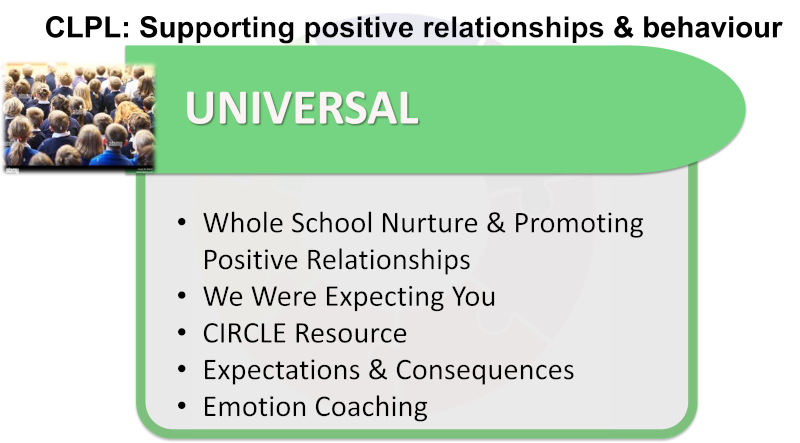
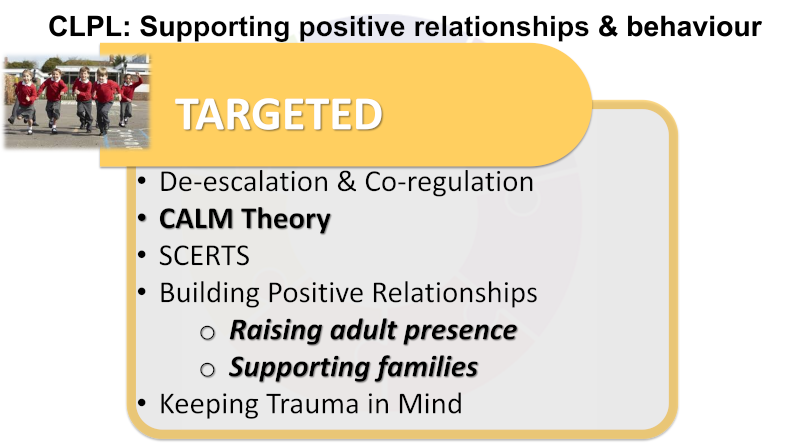
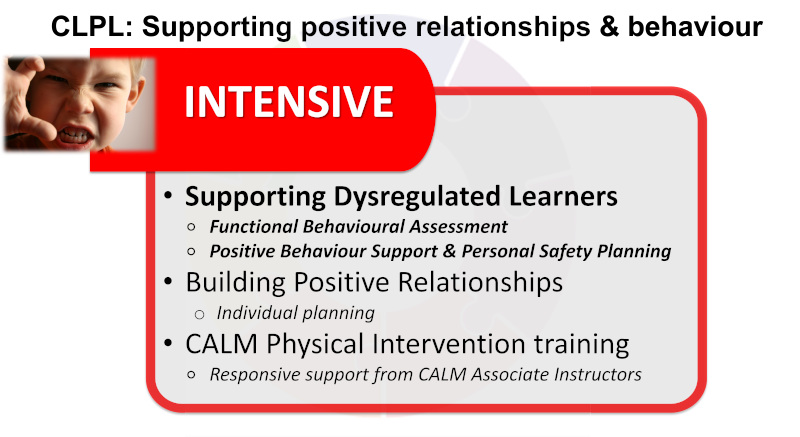
During session 2024-2025, Heads of Establishment and ASN Coordinators were introduced to functional behavioural assessment. This included a full-day training session on CALM theory focusing on universal trauma-informed approaches, an understanding of attachment and de-escalation. This was followed by a further full day exploring the functions of behaviour assessment, positive behaviour planning and personal risk assessment as part of our approach to more targeted and intensive support.
This session we have continued to roll out our Building on Positive Relationships (BPR) family support approach. We have trained a further 39 staff including Area Inclusion Workers, Family Centred Wellbeing Staff and other staff groups in this approach. We have also worked in partnership with Health Social Care and Partnership (HSCP) staff to deliver a further 16 eight week family group sessions, with significant improvements being noted by families in the Strengths and Difficulties Questionnaire and Family Functioning Scale at the end of these sessions. We now have 77 members of staff from a range of Directorates trained to deliver the programme. Overall feedback indicates the following positive outcomes:
- Stronger relationships and resilience in families
- Staff are better equipped with practical skills
- Tangible, positive outcomes for families and staff
We have also run a BPR group to support pupil attendance which was attended by 5 families who found this to be an effective approach to tackling anxiety in their young people.
North Ayrshire now has a range of materials and approaches which can be accessed by staff including trauma-informed and trauma-skilled information, CALM training and work on functional behavioural analysis and Building on Positive Relationships (based on Non Violent Resistance). We continue to work collaboratively with colleagues in the Health and Social Care Partnership to ensure that up to date trauma-informed training is made available to support the individual needs of establishments.
Theme three: Improving attendance
Updating attendance policy and developing a positive campaign to promote school attendance
During session 2024-25, our guidance around promoting positive school attendance has been updated and launched. SEEMIS guidance has been updated and training provided to relevant staff. A working group has been established to quality assure and monitor attendance data.
An Attendance steering group has continued to meet and focus on our core areas outlined below:
Building on existing good practice, a number of facilitated sessions to explore a North Ayrshire campaign and key messaging around promoting attendance have been taken forward. We have shared some key messages as part of a poster visual (also available in audio form) and powerpoints with establishments as part of a pilot to shape our own authority-wide approach, which will be fully launched in session 2025-26. An example of our “attendance matters” posters is displayed on the next page.
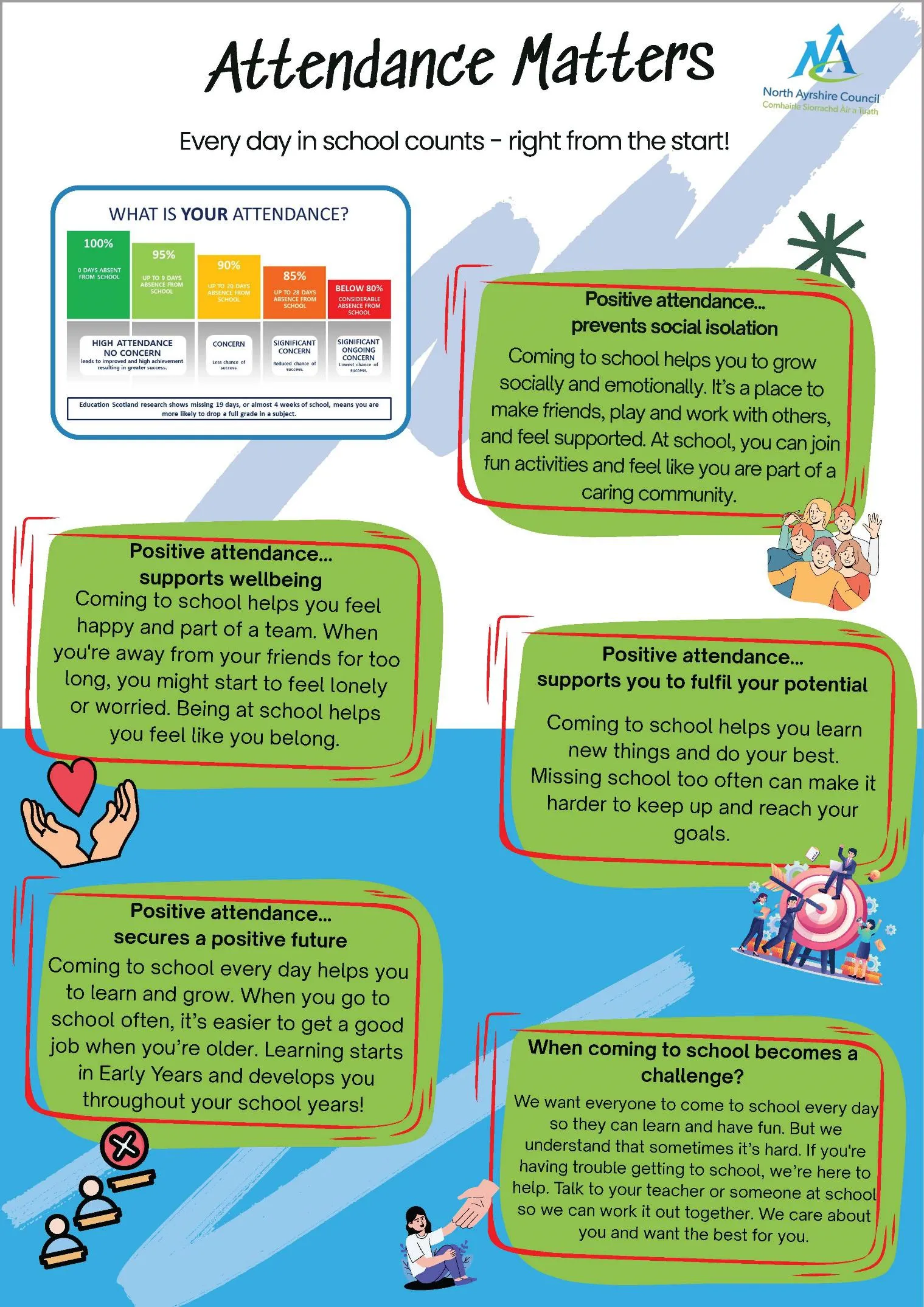
Seemis Guidance has also been produced and a working group continues to meet to monitor the progress in this area. The Power BI tool was further enhanced with Data support sessions offered for senior and middle leaders in the use of this tool.
Five North Ayrshire schools have been involved in an Education Scotland-led Attendance Quality Improvement Project. The 5 schools (Hayocks Primary, St. Winning’s Primary, Corsehill Primary, Irvine Royal Academy and Ardrossan Academy) engaged in this project have attended a number of sessions which supported them to utilise the quality improvement process to develop tests of change using the plan, do, review cycle. Further sharing of good practice to support attendance is ongoing with Ardrossan Academy sharing some of its innovative tracking and support approaches with others.
Responding to emotionally-based school non-attendance
A group of North Ayrshire practitioners have been involved in developing a monitoring and tracking system which will allow a more consistent approach to tracking school attendance whilst identifying the need for early intervention and targeted support using the spectrum of non-attendance.
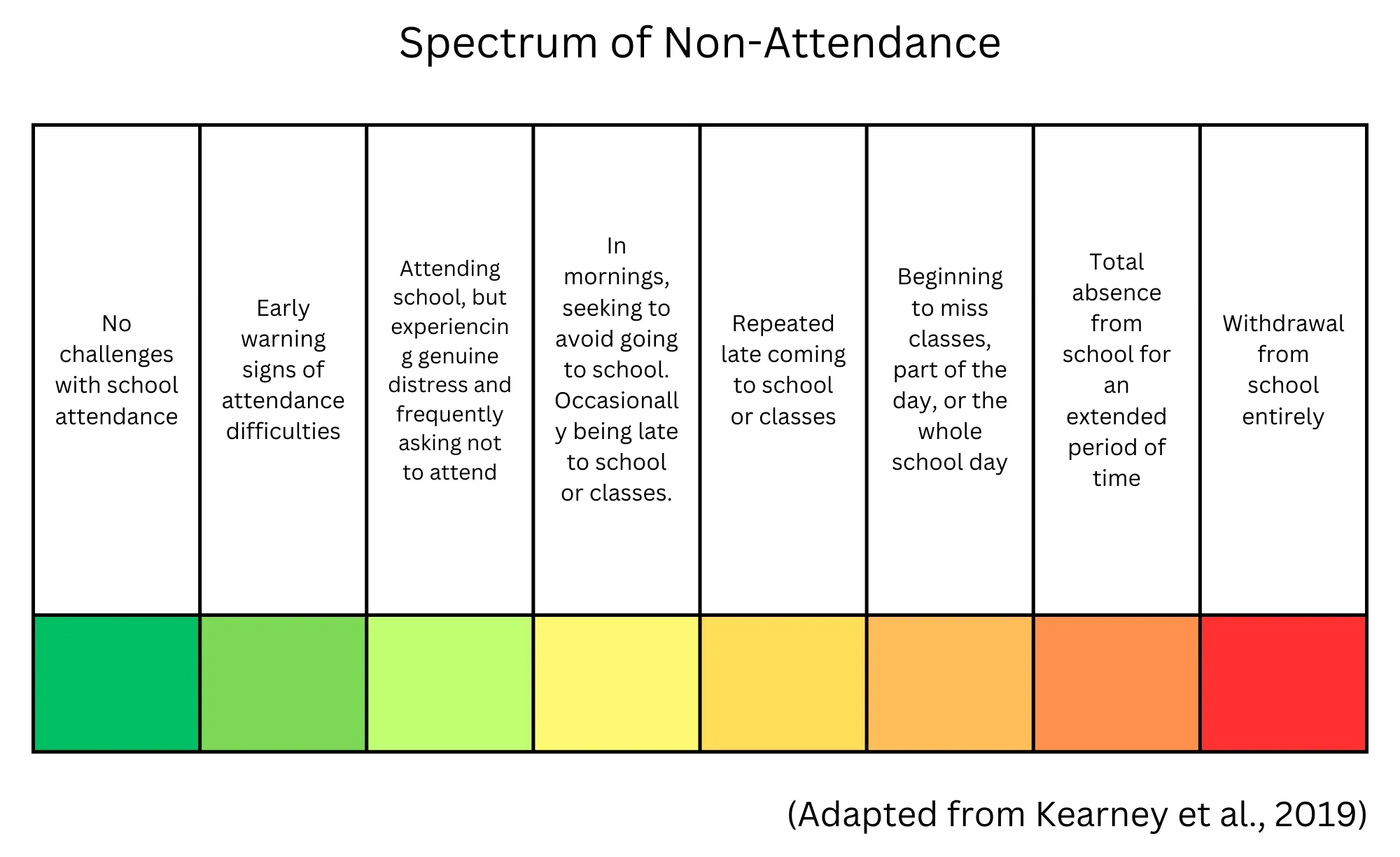
Where early intervention is required, establishments will be guided to a GLOW support page for attendance to utilise risk and resilience tools to help identify needs. Where more targeted support is required a range of tools have been developed to use with children and young people, staff and parents/carers. Accompanying training materials on a staged approach to emotionally-based school non-attendance have been developed and have been quality assured. Guidance to accompany this is being taken forward by the attendance improvement group and will be completed in session 2025/26.
Pupil attendance data
Overall attendance has improved again in 2024-25 by 0.6 percentage points. This marks the second year of improvement following a significant reduction in attendance levels in the years after Covid-19 when normal attendance recording procedures were reinstated across the country. Nationally, there are clear links between higher levels of deprivation and lower attendance. Improving attendance remains a significant priority for improvement, both locally in North Ayrshire and nationally.
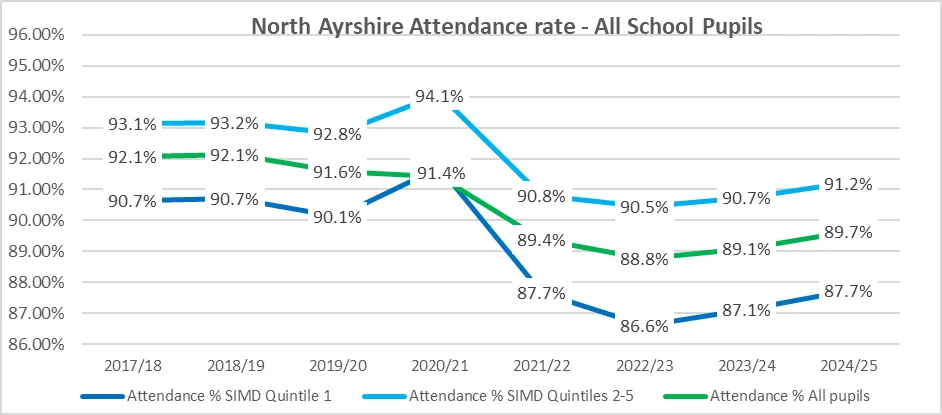
Education Service Priority Five
Placing human rights and needs of every child and young person at the centre of education
Theme one: Supporting needs
Reviewing targeted provisions
During this session we have reviewed 4 of our specialist settings within the Primary estate: Elderbank Supported Learning, Dreghorn Education Support Resource and both Enhanced Nurture Resources at Hayocks and St. Bridget’s Primaries.
Staff teams were working incredibly hard to support the needs of learners with complex autism, language and communication difficulties and a range of other needs.
In terms of the two Enhanced Nurture Resource (ENR) provisions for supporting learners with social, emotional and behavioural needs, these provisions were found to provide a supportive environment and positive regard for children in their care. A process to support transition for ENR pupils back into mainstream primary was updated this session to ensure clarity for all involved. Teams worked hard to enable children to learn and practise new skills in regulation in order to assist their reintegration to mainstream schools.
The model of support has been revised with enhanced staffing provided in both provisions. This will mean children who previously attended on a part-time basis (0.8) will be able to attend full-time. This additional staffing will also strengthen the support available to children during their placement. Approaches to tracking and monitoring attainment and achievement as well as the measurement of impact will be enhance along with the strengthening of approaches to transition back to mainstream.
The review of Outreach Support Services was concluded in August 2024.The review focused on gaining a full understanding of the role and impact of each Service as well as planning next steps for improvement. All seven services were reviewed:
- Deaf Education
- Visual Impairment
- English for Speakers of Other Languages
- Extended Outreach
- Tuition Support
- Early Years Inclusion Support
- Dreghorn Outreach
The review highlighted the team’s consistently strong relationships with children and their families. In addition key strengths were the bespoke, flexible and child-centred approaches to engaging with children, young people and their families as well as the strong and stable leadership of the Principal Teachers.
Individual teams within the Service modelled highly effective practice for colleagues in mainstream establishments. They also consistently delivered bespoke curricula designed to best meet the needs of individual learners.
Next steps focused on the development of a more cohesive and strategic approach to ensure maximum impact for learners. Over the course of this session, we have designed and implemented a revised leadership structure with the appointment of the Virtual Head of Outreach Support Services. Once in post, the Head Teacher will work collaboratively to develop a quality assurance calendar, implement a cycle of improvement planning and self-evaluation, strengthen approaches to the gathering of impact data and enhance transition pathways, protocols and processes at points of entry and exit.
Following these reviews and in line with the priorities laid out in the Children’s Services Plan, we have identified the creation of a quality improvement tool as an essential element in supporting establishments to evaluate the quality of provision. Working alongside colleagues outwith North Ayrshire, we are developing a tool based on How Good Is Our School⁴, ‘How Good is our Support for Learning’. This will cover universal, targeted and specialist approaches and provisions.
Theme two: Maximising learner participation and voice
The new Learner Participation policy and operating procedure (POP) was launched across all establishments. The Young Leaders of Learning programme was piloted by 11 Early Years centres and schools. This programme enhanced opportunities to maximise learner participation and learner voice across the pilot establishments. A sharing practice event is planned for later in the year.
In partnership with the North Ayrshire Youth Services Team in the Communities and Housing Directorate, there has been ongoing engagement and consultation with our young people through various methods, including Joint Cabinet. Discussion topics are co-designed and produced with young people, based on issues which are important to them. The outputs of discussions at Joint Cabinet are used to inform policies, plans and service delivery across a range of local services.
Young Carers have once again benefitted from the Young Carers Education Fund. The fund can be used for anything that will improve or maintain the young person’s physical, emotional mental health and wellbeing or life chances, reduce social isolation, and improve attainment. 115 children and young people have accessed the fund this year. Young Carers work with a key adult to complete a young carers statement and co-design any supports. Funds have been used for driving lessons, days out to have a break from caring such as funding a cinema pass to allow the young person get time away from caring responsibilities each week. The fund has also been used to support Young Carers pursue hobbies and interests, for example the purchase of cookbooks and utensils to support a love of cooking.
We have 17 establishments who have achieved Gold status in Rights Respecting School Awards, 29 have achieved Silver and 12 have achieved Bronze. We have identified two colleagues to act as trainers for the Rights Respecting School Awards and who will carry out assessments of those provisions seeking a Silver Award. The Rights Respecting Schools working group will meet with UNICEF to plan the professional learning programme for schools and early years centres. Part of this work will be to review establishment policies to ensure they explicitly consider and promote children’s rights as well as promoting child-friendly versions where appropriate.
Theme three: Maximising parent/carer involvement and engagement
Establishing an authority-wide forum for families of children with identified needs
In July 2024 we met with two Ayrshire-based parental and family support groups. Both groups represented families across Ayrshire who had children with additional needs. During this meeting we discussed approaches to communication, engagement, participation and partnership with families and decided to pilot a ‘Family Engagement Hub’.
We worked collaboratively over a number of planning sessions to design four meetings specifically for parents which would be led by the Executive Manager. The subjects were:
- Staged Intervention
- The Placement Process
- When Things Go Wrong
- Open Questions and Answers
The sessions were advertised by the parent groups themselves who ran the booking system. 3 of the 4 sessions were well attended with 100% of attendees reporting the sessions to be informative, engaging and positive despite some of the subject matter. The Neurodevelopmental Empowerment & Strategy Team (NEST) have also been attending the events which has strengthened partnership working and built relationships. Updated literature around how needs are supported within early years settings and schools has been refreshed and distributed through this forum as well as being circulated to all establishments to share with parents and carers.
A review of the sessions in June 2025 identified next steps for the programme in 2025/26 including:
- Offering one session at two different times to enable working parents to attend
- Ensuring the sessions continue to be run and attended by senior officers within the Service
- Linking the sessions to the calendar year e.g. the first session to be about the placement process in August with a later session focusing on supporting transitions.
Discussions during the sessions have been very productive with information shared and ideas for improving the Service incorporated into our Service Improvement Plans for session 25/26. This will include developing our communication strategy around the meetings to ensure we are reaching out to as many parents as possible next session.
Inspection and Review
Supporting school improvement is a key role of the Education Service. In June 2024, a national thematic inspection was carried out across all 32 Scottish local authorities to evaluate how effectively they support school improvement. The review focused on four themes: improvement planning/reporting, self-evaluation, professional learning, and school support.
The inspection identified strong national practice in collaborative planning, professional learning, and school-level support. North Ayrshire’s Professional Learning Academy was included as a national practice example in the final published report, reflecting the strength of this in-house delivery model as part of our overall approach to supporting the professional learning needs of our education workforce. In addition, our well-established Quality Improvement Framework was identified in our local report as an example of effective practice worth sharing, given its pivotal role in underpinning our work to support school improvement across the service.
A summary of inspection feedback in relation to the performance of NAC Education Service is included below:
Supporting Effective Improvement Planning and Standards and Quality Reporting
- The Quality Improvement Framework (QIF) provides clear guidance on self-evaluation, planning, and reporting, ensuring consistency.
- Strong leadership and collaboration foster trust, enabling honest discussions and tailored support for schools.
- Schools use data-driven decision-making, incorporating attainment, attendance, and stakeholder feedback.
- A structured stakeholder engagement process, including parents and learners, supports improvement planning.
Supporting Schools to Improve the Quality of Education Through Self-Evaluation and Quality Assurance
- A rigorous quality improvement cycle includes school visits, data analysis, and peer collaboration.
- Improvement Trios and cross-sector work enhance self-evaluation and best practice sharing.
- Frequent moderation of data and reviews ensure targeted support and accountability.
- The authority has refined its school visit model to allow more flexible, needs-based engagement.
Supporting Schools to Improve the Quality of Education Through Professional Learning
- The Professional Learning Academy (PLA) offers structured, in-school support, including “in residence” training.
- Peer networks and mentoring provide collaboration opportunities for school leaders and staff.
- The council is expanding subject networks and leadership development across primary and secondary schools.
- Increased focus on evaluating the impact of professional learning ensures sustainable school improvement.
Delivering Universal Support and Challenge for All Schools, and/or Targeted Support for Specific Schools to Improve the Quality of Education
- A structured universal support system provides clear expectations and ongoing engagement.
- Schools receive tailored interventions based on data analysis to address specific challenges.
- Targeted action plans and peer mentoring help schools improve learning experiences and attainment.
- A strong culture of professional challenge and support ensures accountability while fostering positive relationships.
Local recommendations
- Further strengthen learner involvement in school evaluation and planning.
- Enhance cross-sector collaboration – expand peer evaluation, subject networks, and transition links between primary and secondary schools.
- Enhance systematic evaluation of impact of professional learning to support long-term effectiveness.
A key feature of our well-established Quality Improvement Framework is the implementation of establishment reviews, to support senior leaders to evaluate the quality of aspects of their educational provision. These are usually 2-day reviews, focusing on one or two quality indicators from the self-evaluation framework “How Good is Our School?: 4th edition”. The review teams are made up of senior managers from the central quality improvement team alongside senior school leaders. In session 2024-25, a total of 15 in-house establishment reviews were undertaken.
In addition, His Majesty’s Inspectors of Education (HMIe) and the Care Inspectorate carried out external inspections in our schools and early years settings. The outcomes of these inspections are noted below:
| School | Inspection Report Date | 1.3 Leadership of change | 2.3 Learning, teaching and assessment | 3.1 Ensuring wellbeing, equality and inclusion | 3.2 Raising attainment and achievement |
|---|---|---|---|---|---|
| Dykesmains Primary School* | 12/12/2023 | [Not assessed] | Very Good | [Not assessed] | Very Good |
| St Mark’s Primary School* | 06/02/2024 | [Not assessed] | Satisfactory | [Not assessed] | Satisfactory |
| Winton Primary School* | 27/02/2024 | [Not assessed] | Good | [Not assessed] | Good |
| Cumbrae Primary School* | 23/04/2024 | Very Good | Very Good | Very Good | Very Good |
| Gateside Primary School* | 28/05/2024 | Very Good | Very Good | Very Good | Very Good |
| Kilmory Primary School | 27/08/2024 | [Not assessed] | Satisfactory | [Not assessed] | Satisfactory |
| Pirnmill Primary School | 27/08/2024 | [Not assessed] | Weak | [Not assessed] | Weak |
| Fairlie Primary School | 19/11/2024 | [Not assessed] | Good | [Not assessed] | Good |
| Blacklands Primary School | 04/02/2025 | Very Good | Good | Very Good | Good |
| St Anthony’s Primary School | 04/06/2025 | [Not assessed] | Good | [Not assessed] | Good |
Three other inspections took place at the end of the 2024-25 school year, however these reports have not yet been finalised and will therefore be included in a future Standards and Quality Report.
| School | Inspection Report Date | 1.3 Leadership of change | 2.3 Learning, teaching and assessment | 3.1 Ensuring wellbeing, equality and inclusion | 3.2 Securing children’s progress |
|---|---|---|---|---|---|
| Cumbrae Primary Early Years* | 23/04/2024 | Good | Good | Good | Good |
| Gateside Primary Early Years* | 28/05/2024 | Very Good | Very Good | Very Good | Very Good |
| Kilmory Primary Early Years | 27/08/2024 | [Not assessed] | Good | [Not assessed] | Good |
| Blacklands Primary Early Years | 04/02/2025 | Very Good | Very Good | Very Good | Very Good |
| Early Learning and Childcare Setting (NAC) | Inspection Report Date | KQ1: How good is our care, play and learning? | KQ2: How good is our setting? | KQ3: How good is our leadership? | KQ4: How good is our staff team? |
|---|---|---|---|---|---|
| Fairlie Primary School Nursery Class* | 11/10/2023 | Very good | Good | Good | Very Good |
| Lamlash Primary School Nursery Class* | 06/11/2023 | Very Good | Very Good | Very Good | Very Good |
| Brodick Primary School Nursery Class* | 04/12/2023 | Very Good | Very Good | Very Good | Very Good |
| Pennyburn Primary School Nursery Class* | 28/03/2024 | Adequate | Adequate | Adequate | Adequate |
| Annick Primary School Nursery Class* | 17/04/2024 | Very Good | Very Good | Good | Good |
| Hayocks Primary School Nursery Class* | 11/05/2024 | Good | Good | Good | Adequate |
| Gateside Primary School Nursery Class* | 29/05/2024 | Very Good | Very Good | Very Good | Very Good |
| Springvale Early Years Centre | 15/08/2024 | Very Good | Very Good | Very Good | Very Good |
| St Peter’s Primary School Nursery Class | 23/10/2024 | Adequate | Good | Adequate | Adequate |
| West Kilbride Primary School Nursery Class | 05/11/2024 | Very Good | Good | Good | Very Good |
| Garnock Community Campus (nursery) | 09/12/2024 | Good | Good | Very Good | Good |
| Woodlands Primary School Nursery Class | 10/12/2024 | Adequate | Adequate | Adequate | Adequate |
| Pennyburn Primary School Nursery Class | 05/03/2025 | Adequate | Good | Good | Good |
| Beith Primary School Nursery Class | 03/04/2025 | Good | Good | Good | Good |
| Lawthorn Primary School Nursery Class | 10/04/2025 | Good | Very Good | Good | Good |
| Abbey Primary School Nursery Class | 29/05/2025 | Good | Good | Good | Good |
| Stanley Primary School Nursery Class | 19/06/2025 | Good | Good | Very Good | Very Good |
Progress towards Stretch Aims
For the first time in 2022-23, all local authorities were required to set stretch aims, to indicate the progress they intended to make on a range of improvement activities. In the tables below, North Ayrshire’s stretch aims for 2024-25 are recorded along with the baseline position in 2022 and the actual position by August 2025. Overall, whilst there have been improvements in performance over time, progress towards the specific 2026 stretch aims is limited. The legacy impacts of the COVID pandemic are still evident. To show progress over a longer time frame, several years of historical data are available for comparison. Data which is currently unavailable, but due to be published later this year, will be added to an updated version in due course. The six core stretch aims are as follows:
- Core Stretch Aim 1: The proportion of learners in North Ayrshire who achieve the expected levels of attainment in literacy at P1, P4 and P7 will increase
- Core Stretch Aim 2: The proportion of learners in North Ayrshire who achieve the expected levels of attainment in numeracy at P1, P4 and P7 will increase
- Core Stretch Aim 3: The proportion of school leavers who achieve 1 or more awards at SCQF level 5 or better will increase
- Core Stretch Aim 4: The proportion of school leavers who achieve 1 or more passes at SCQF level 6 (grades A-C) or better will increase
- Core Stretch Aim 5: The proportion of 16-19 year-olds who are participating in education, employment or training will increase
- Core Stretch Aim 6: School attendance levels will increase
| Core Outcomes for Improvement | Performance Measure | Stretch Aim (by August 2026) | Progress by August 2025 |
|---|---|---|---|
| Core Stretch Aim 1 | All learners | 75% | 69% |
| SIMD Quintile 1 | 72% | 62% | |
| SIMD Quintiles 2-5 | 80% | 74% | |
| SIMD Quintile 5 | 88% | 81% | |
| Gap 1 (Q1 vv Q2-5) | -8pp | -12pp | |
| Gap 2 (Q1 vv Q5) | -16pp | -19pp | |
| Core Stretch Aim 2 | All learners | 81% | 76% |
| SIMD Quintile1 | 78% | 71% | |
| SIMD Quintiles 2-5 | 86% | 81% | |
| SIMD Quintile 5 | 91% | 87% | |
| Gap 1 (Q1 vv Q2-5) | -8pp | -10pp | |
| Gap 2 (Q1 vv Q5) | -13pp | -16pp | |
| Core Stretch Aim 3 | All learners | 92% | 87% |
| SIMD Quintile 1 | 89% | 82% | |
| SIMD Quintiles 2-5 | 95% | 93% | |
| SIMD Quintile 5 | 98% | 99% | |
| Gap 1 (Q1 vv Q2-5) | -6pp | -11pp | |
| Gap 2 (Q1 vv Q5) | -9pp | -17pp | |
| Core Stretch Aim 4 | All learners | 74% | 68% |
| SIMD Quintile 1 | 62% | 58% | |
| SIMD Quintiles 2-5 | 80% | 77% | |
| SIMD Quintile 5 | 90% | 88% | |
| Gap 1 (Q1 vv Q2-5) | -18pp | -19pp | |
| Gap 2 (Q1 vv Q5) | -28pp | -30pp | |
| Core Stretch Aim 5 | All learners | 95% | 92.50% |
| SIMD Quintile 1 | 92.50% | 90.00% | |
| SIMD Quintiles 2-5 | 97.50% | 94.70% | |
| SIMD Quintile 5 | 99% | 97.10% | |
| Gap 1 (Q1 vv Q2-5) | -5pp | -4.7pp | |
| Gap 2 (Q1 vv Q5) | -6.5pp | -7.1pp | |
| Core Stretch Aim 6 | All learners | 93% | 89.70% |
| SIMD Quintile 1 | 92% | 87.70% | |
| SIMD Quintiles 2-5 | 94% | 91.20% | |
| SIMD Quintile 5 | 95.50% | 92.60% | |
| Gap 1 (Q1 vv Q2-5) | -2pp | -3.5pp |
 Translate
Translate